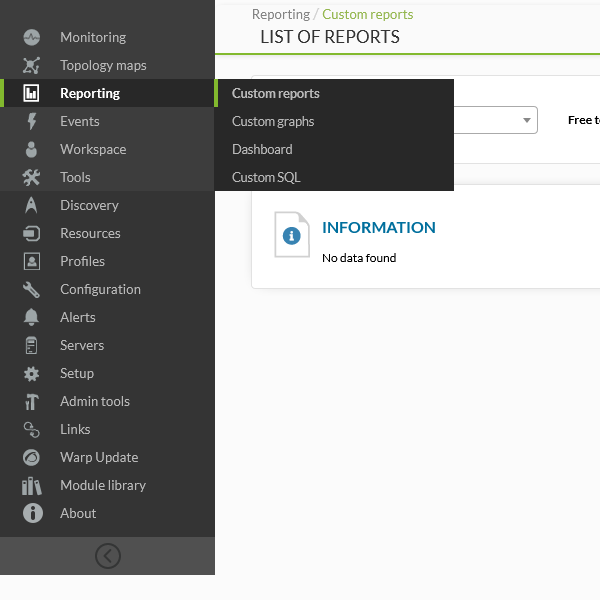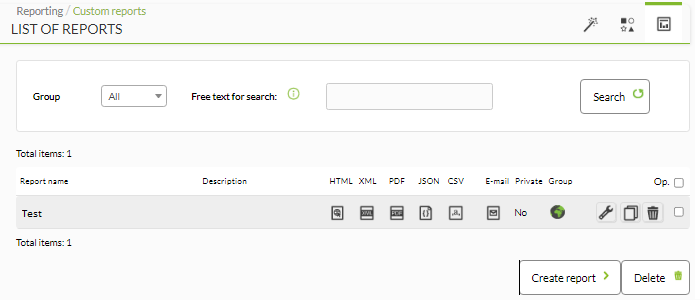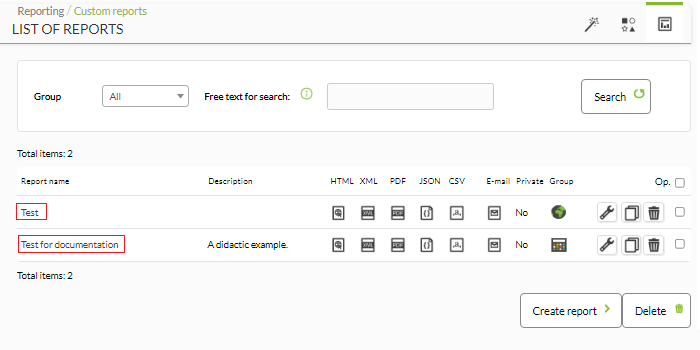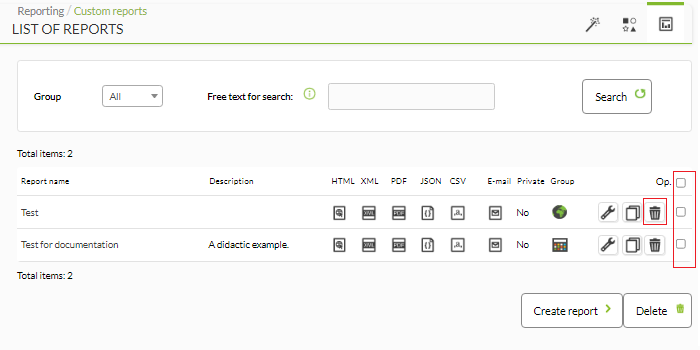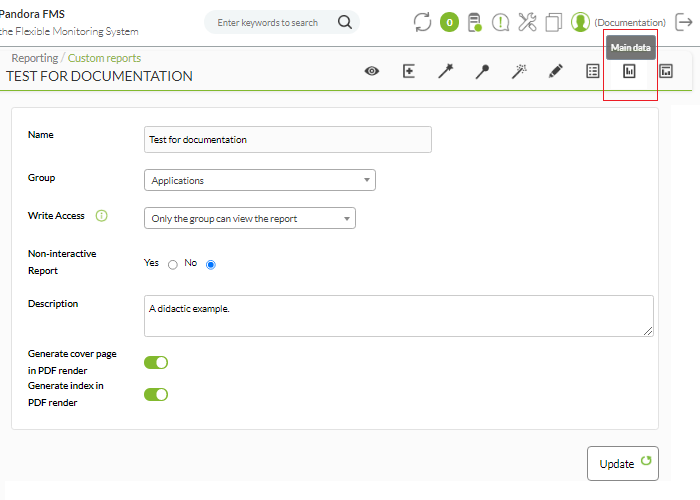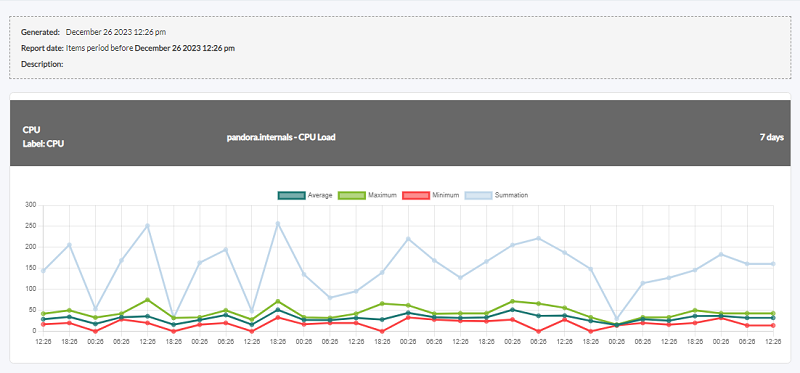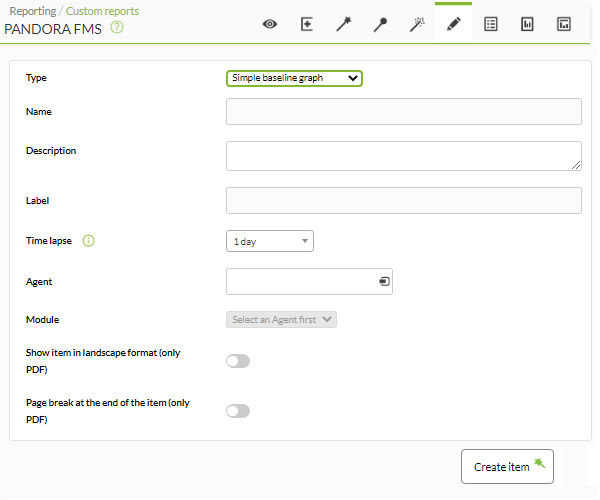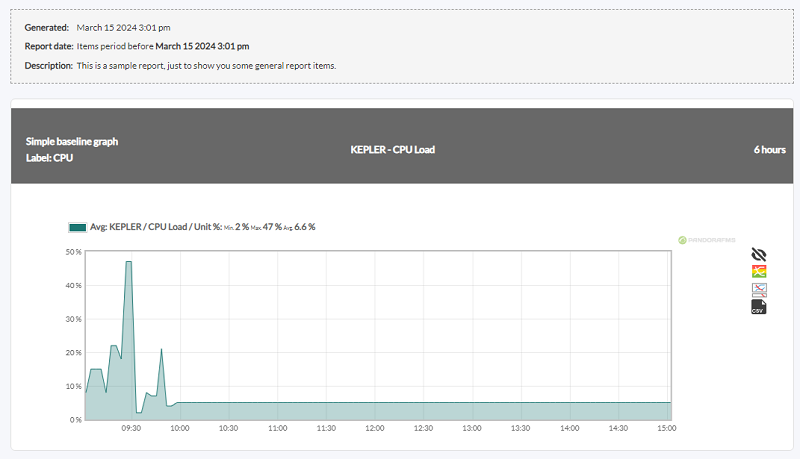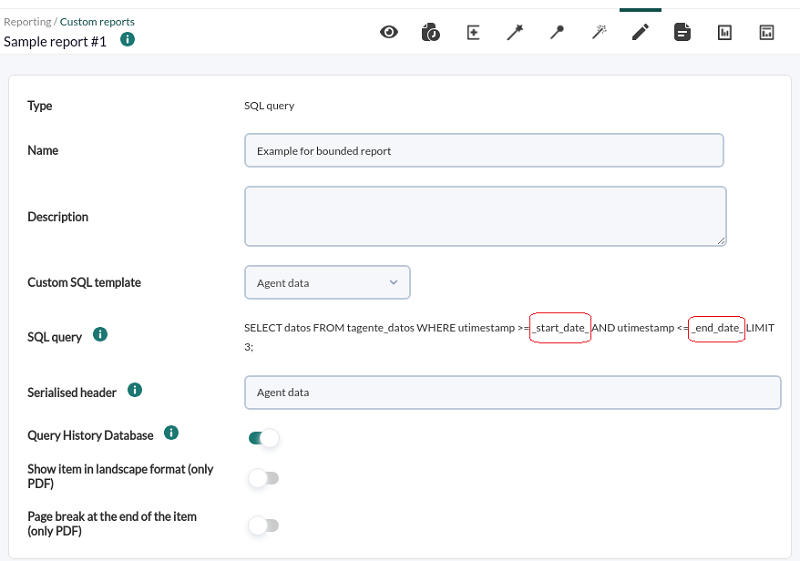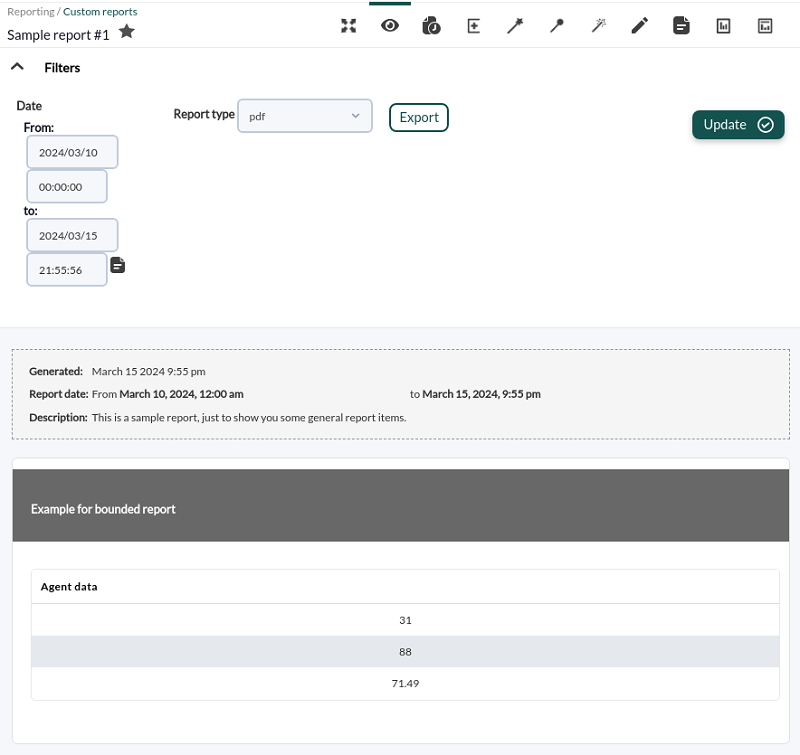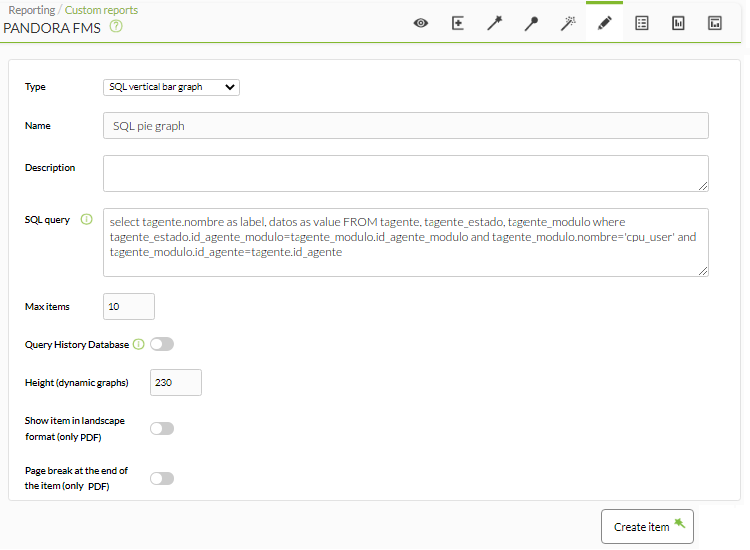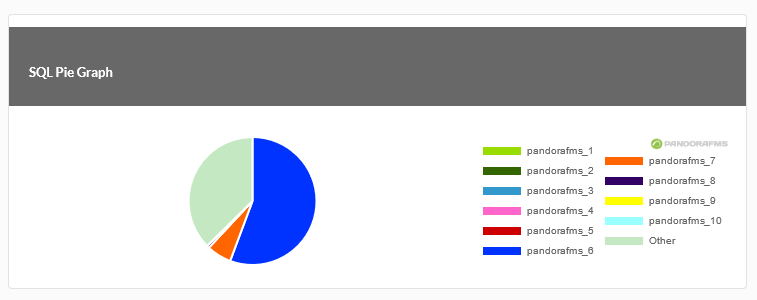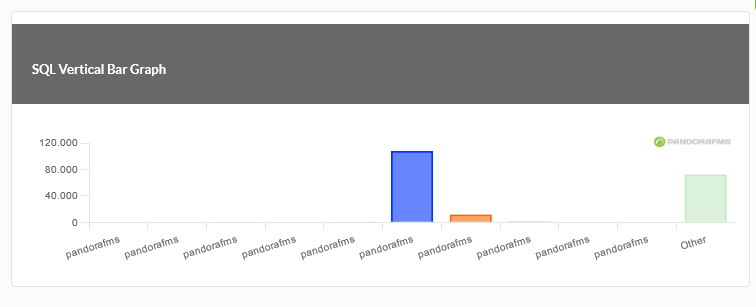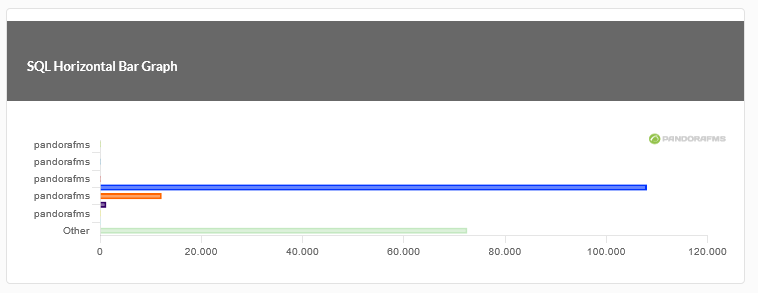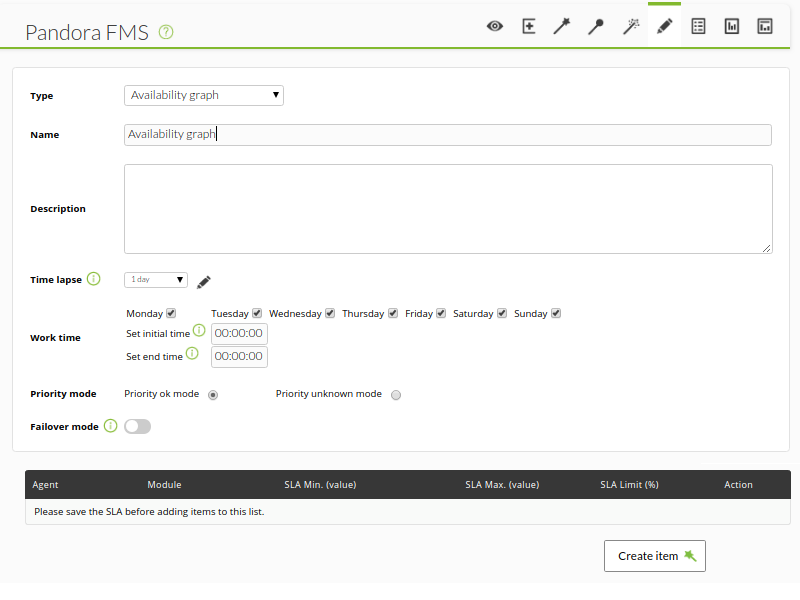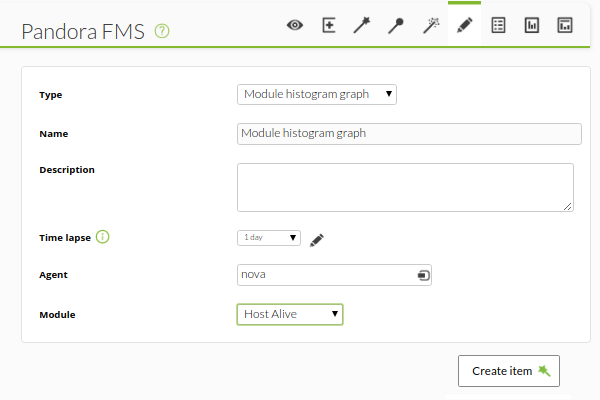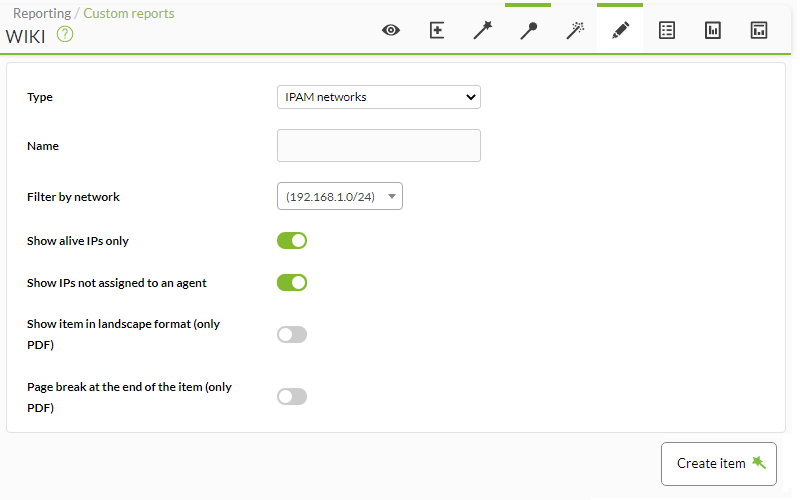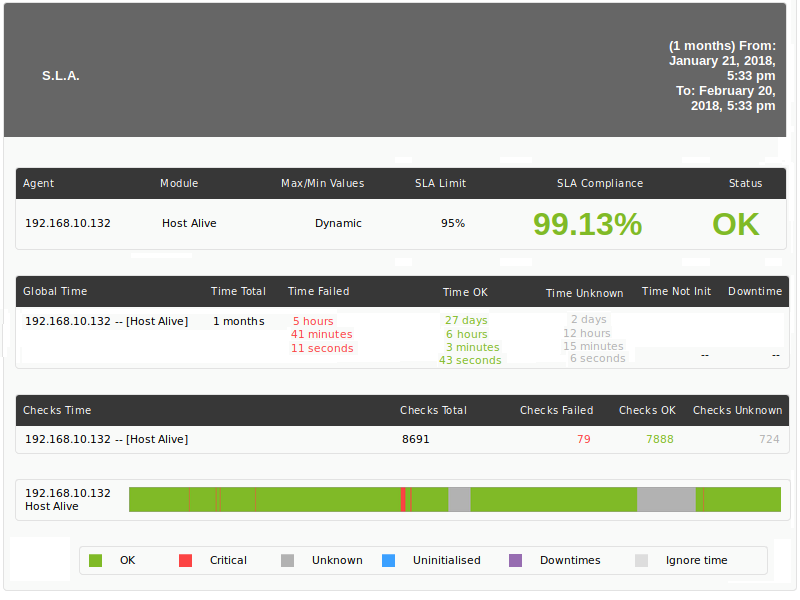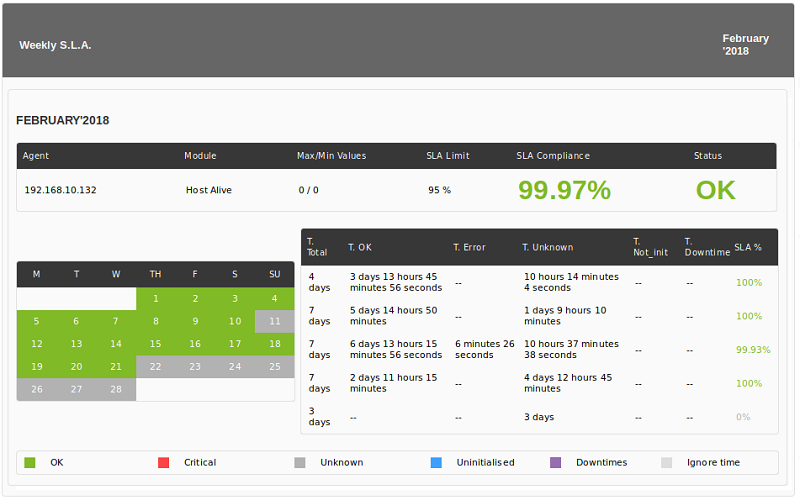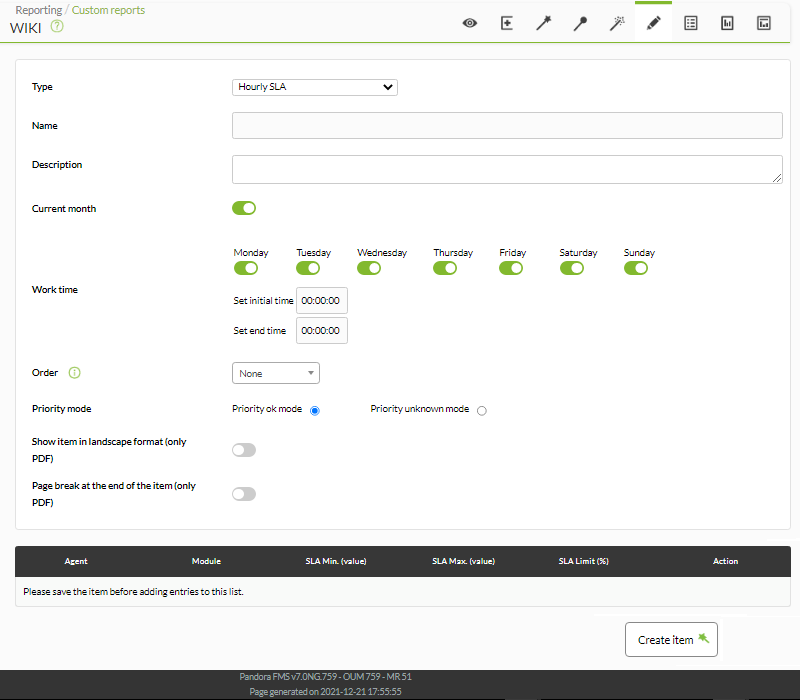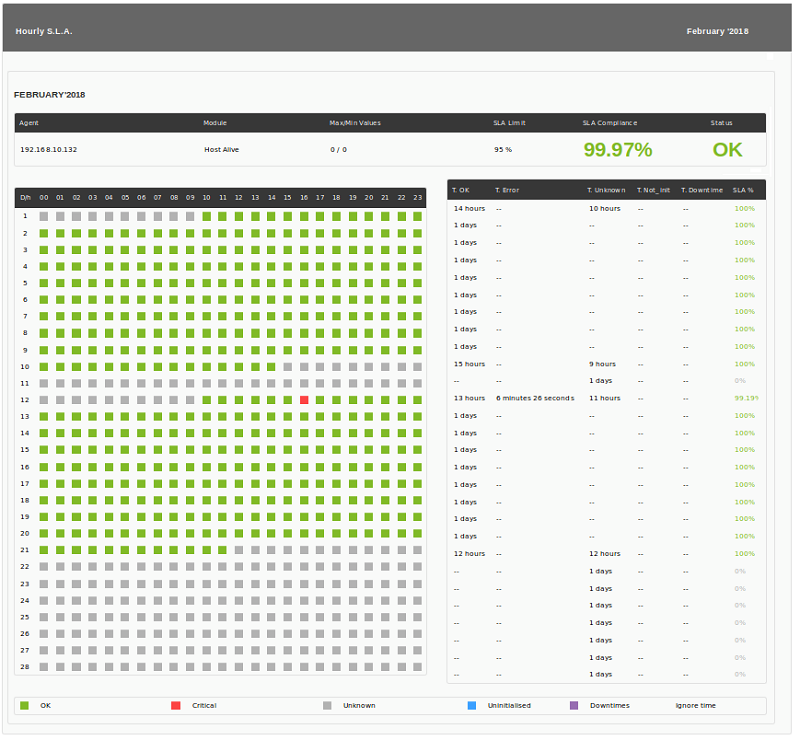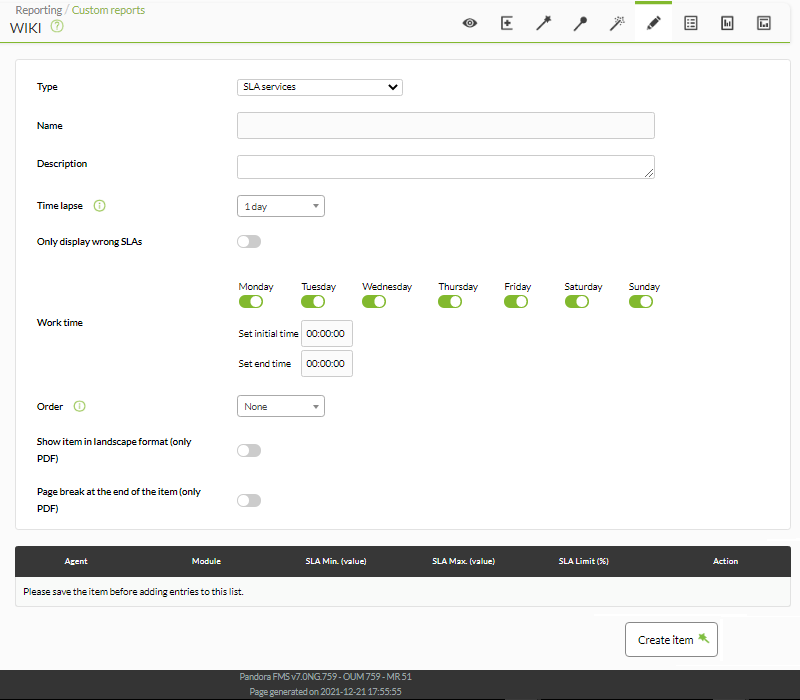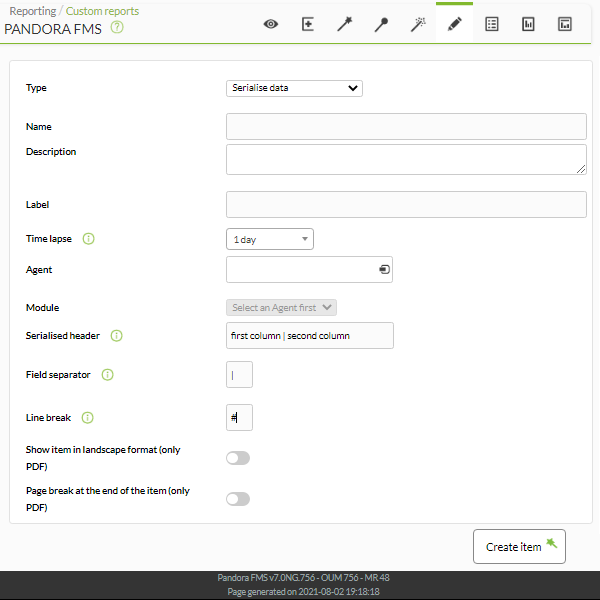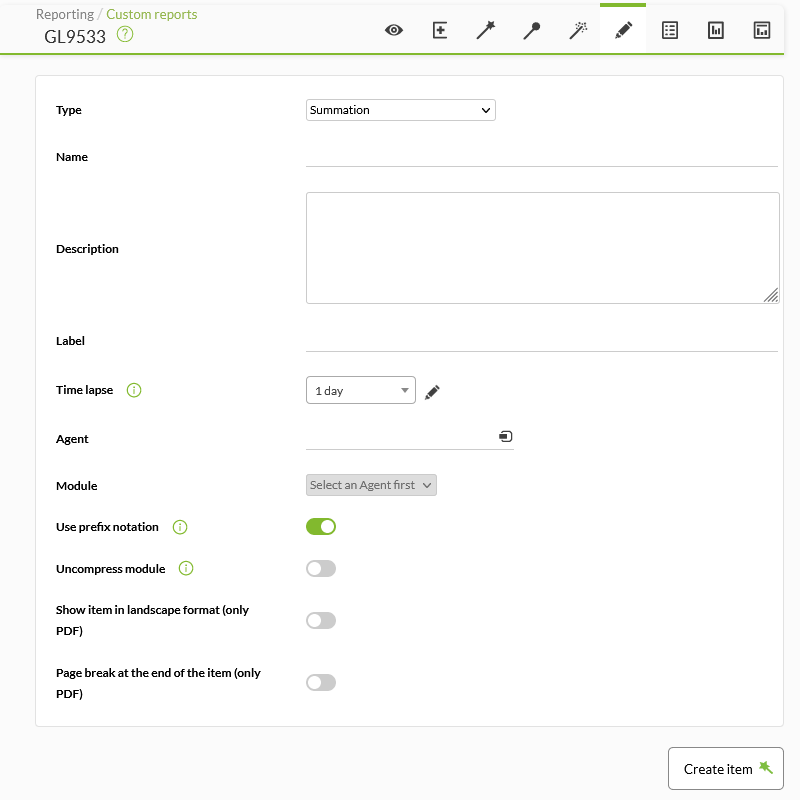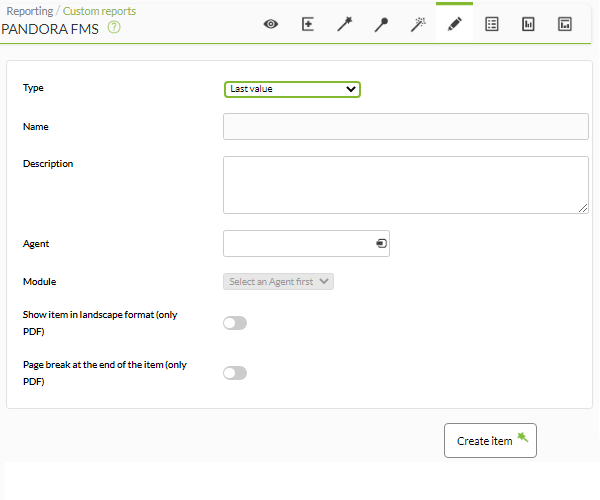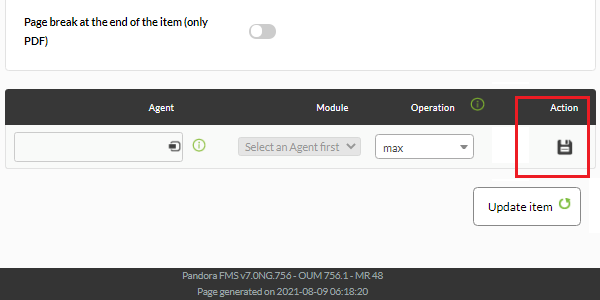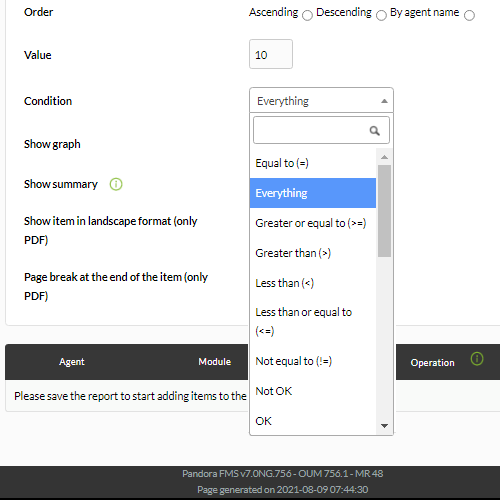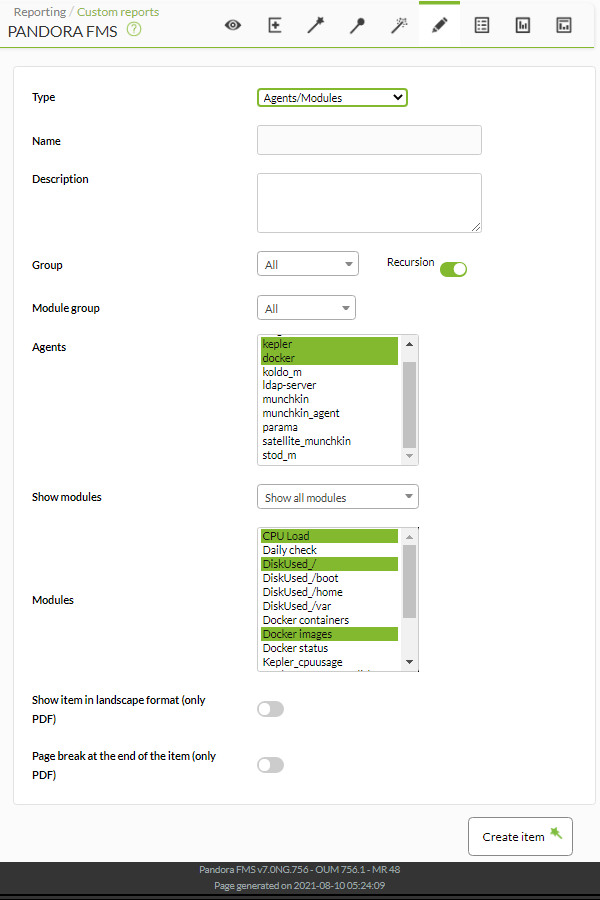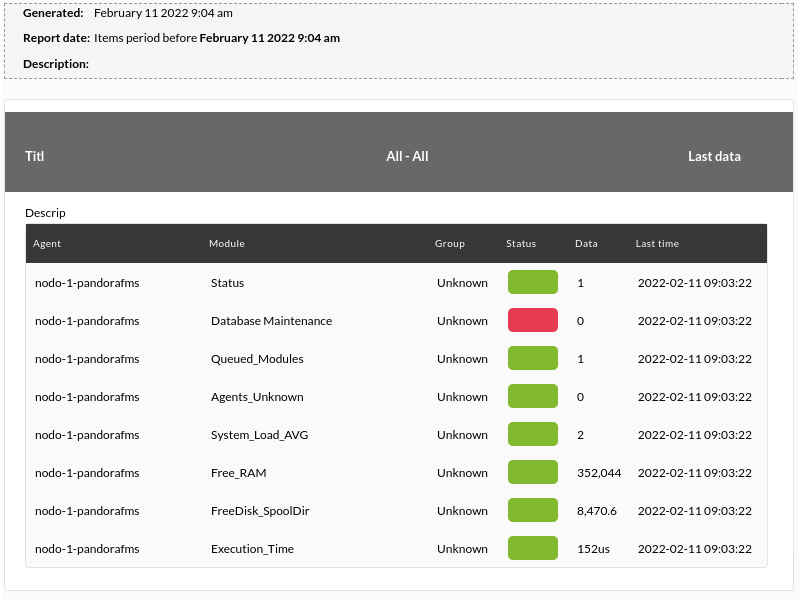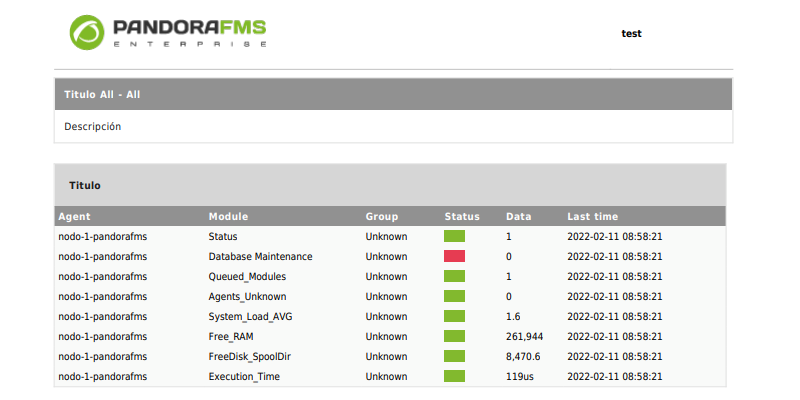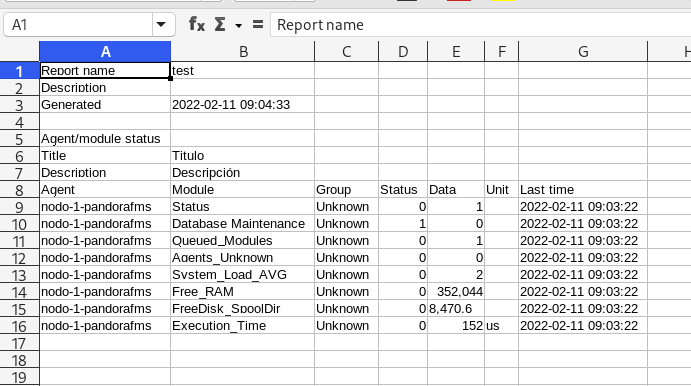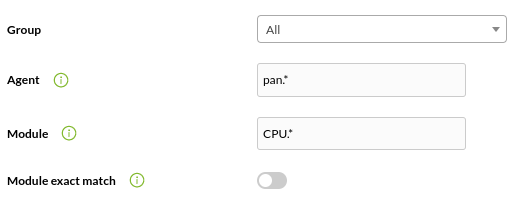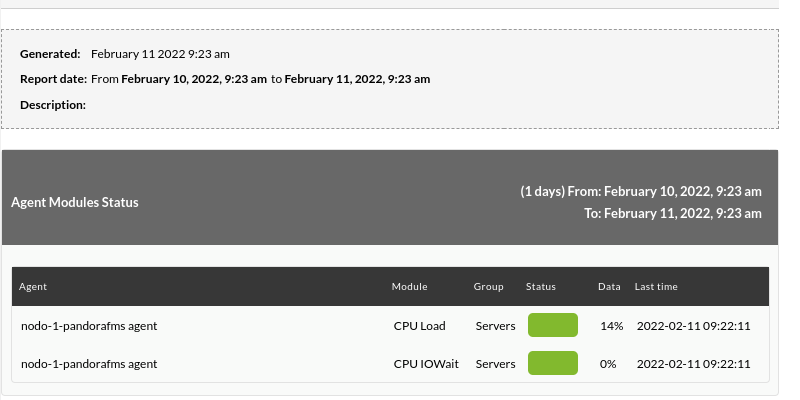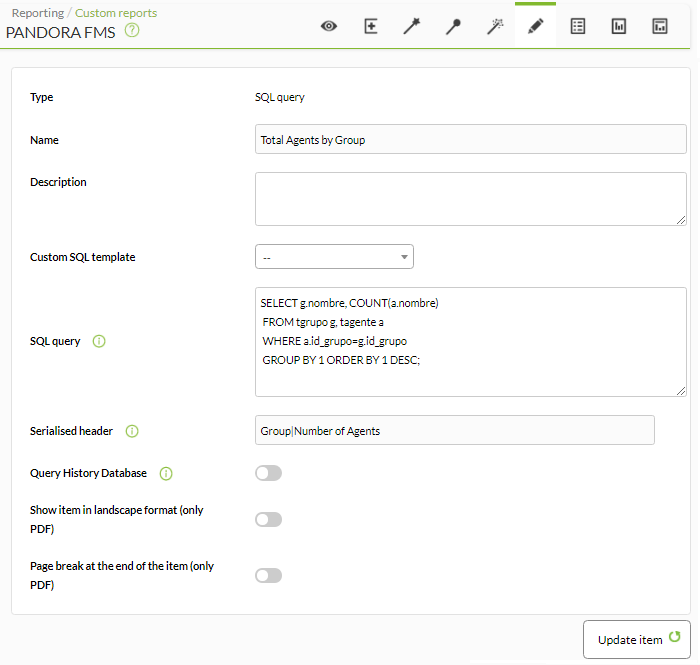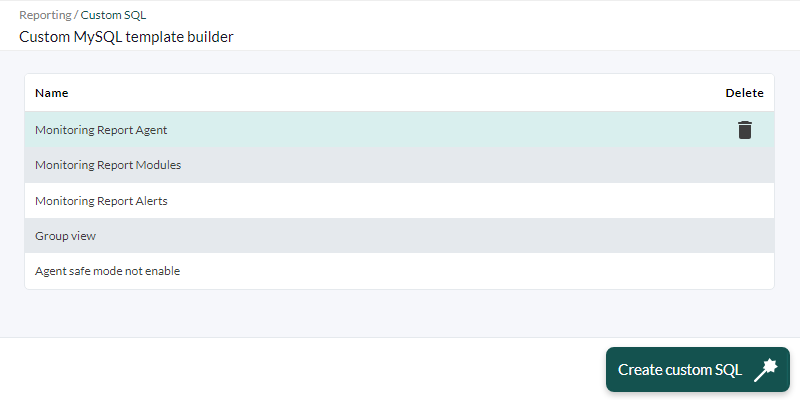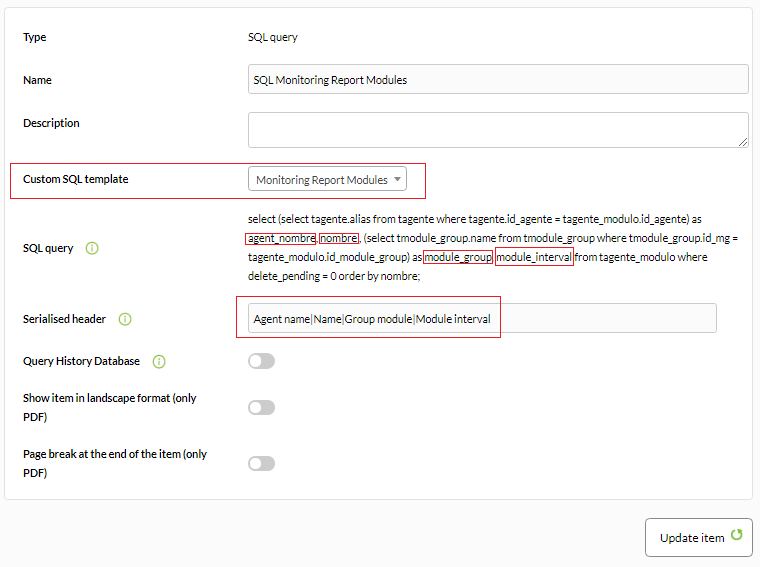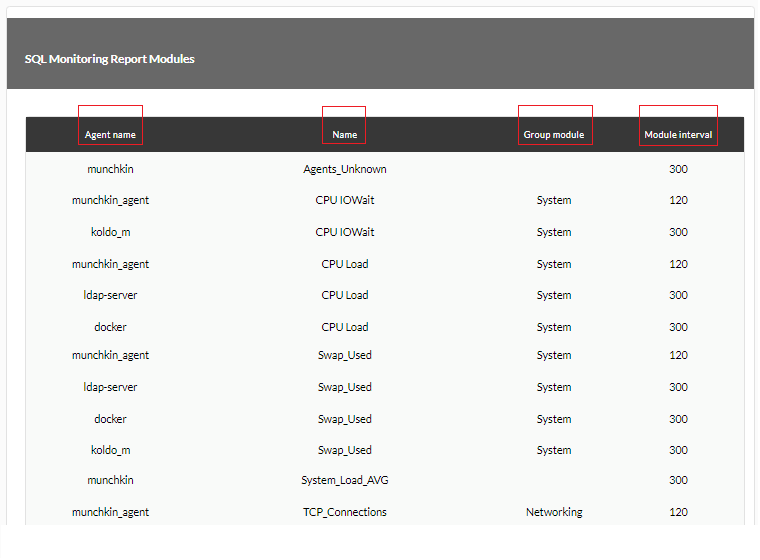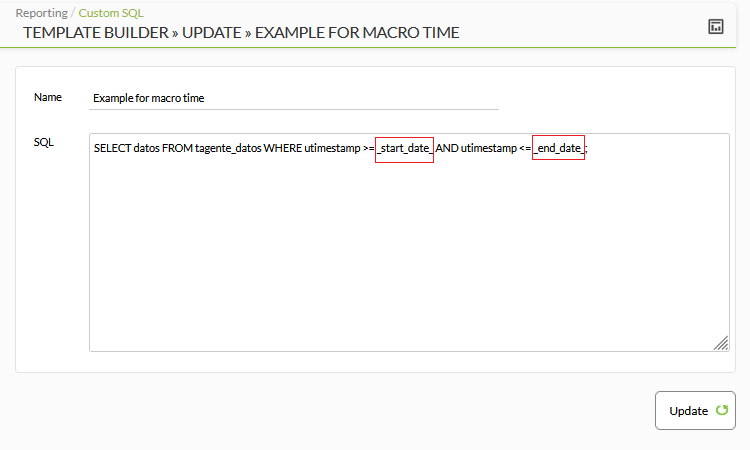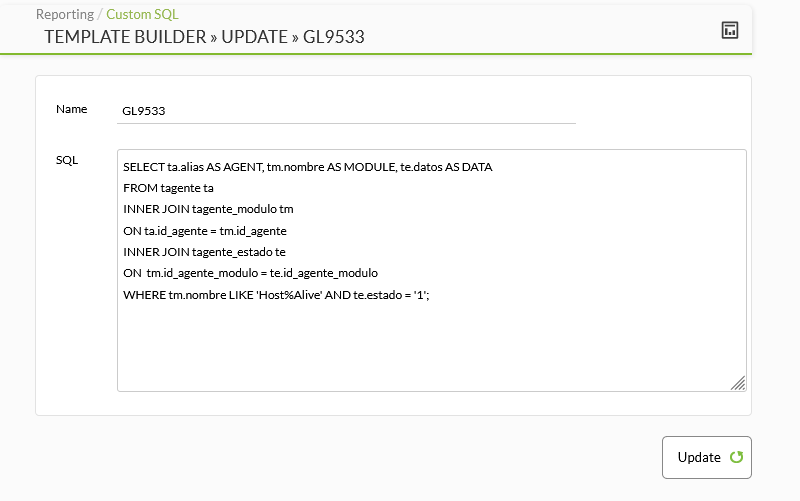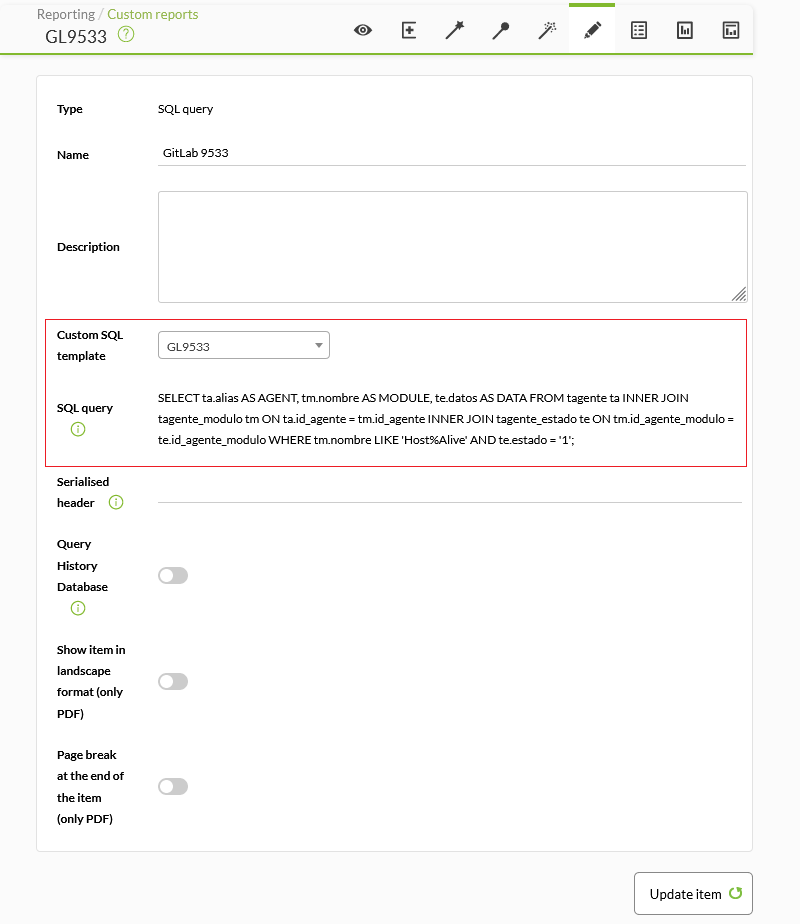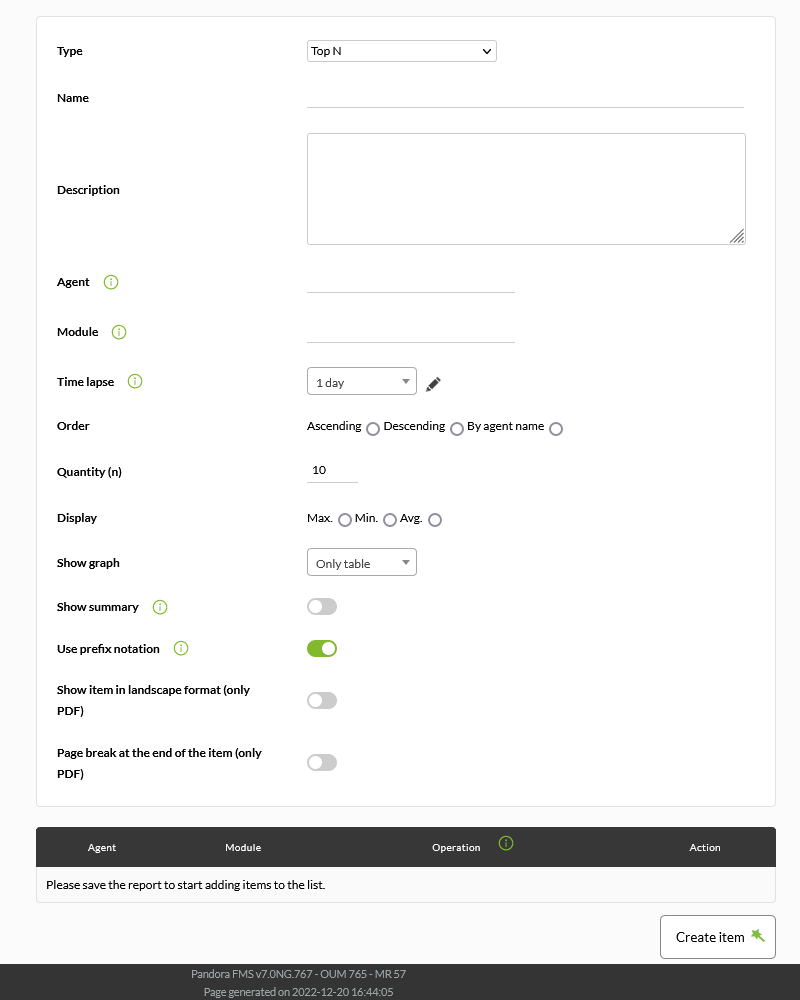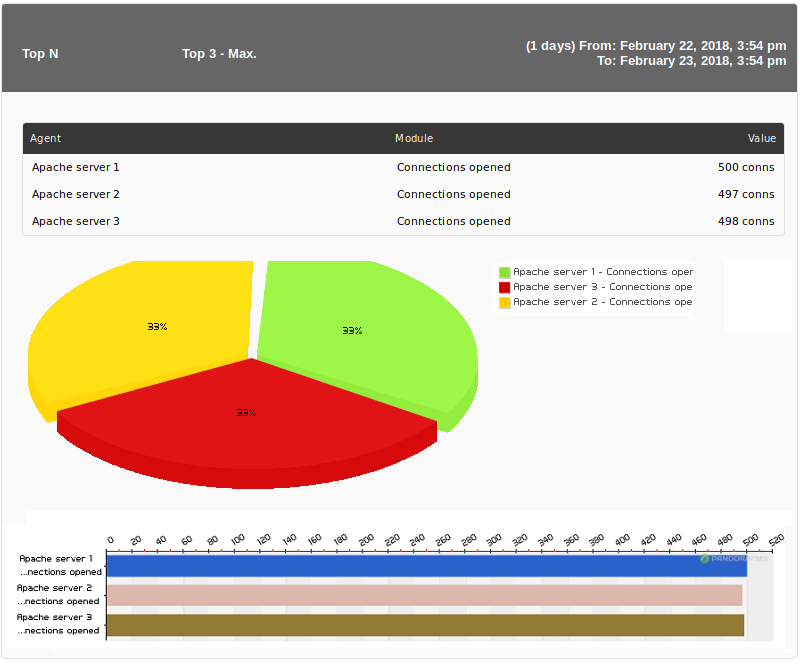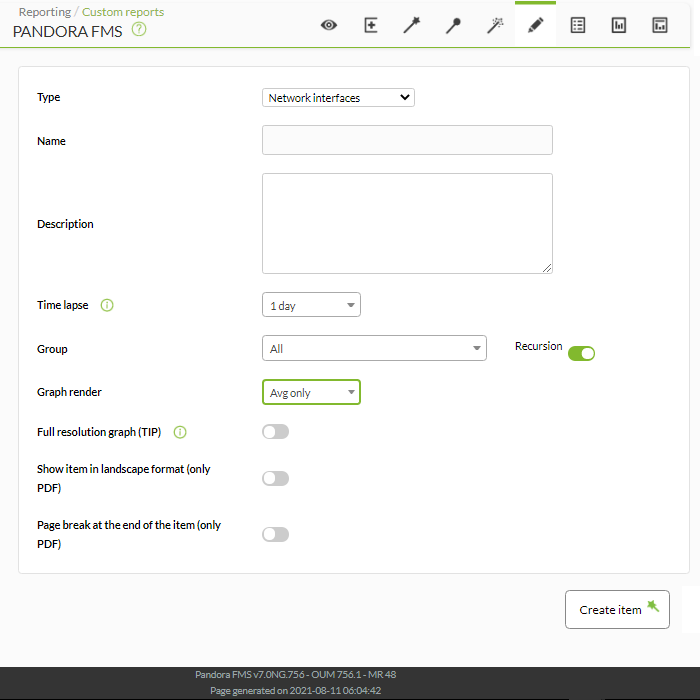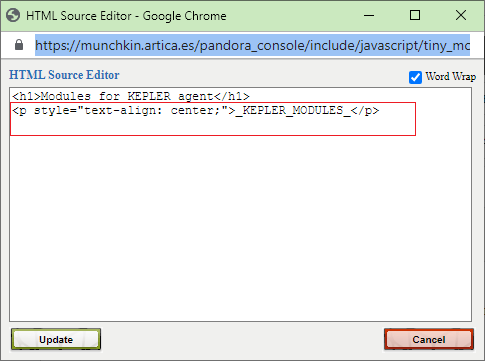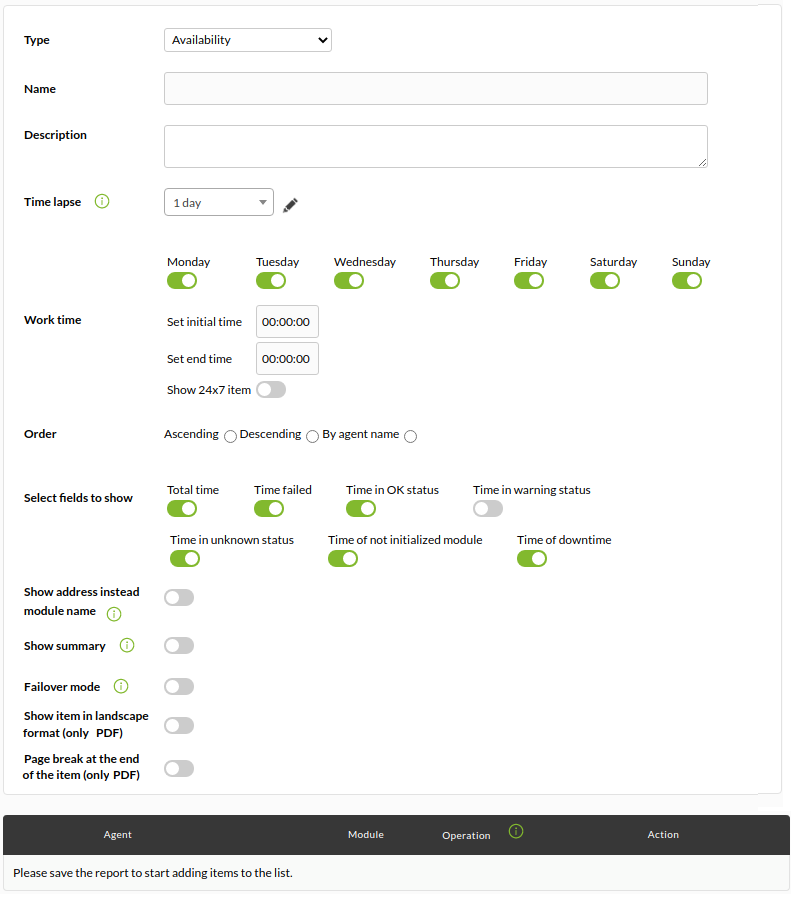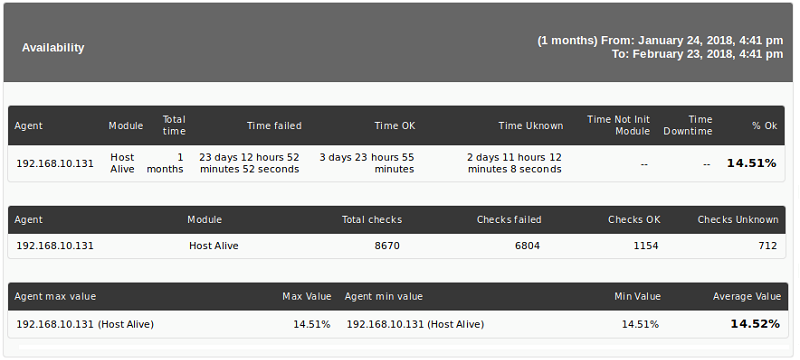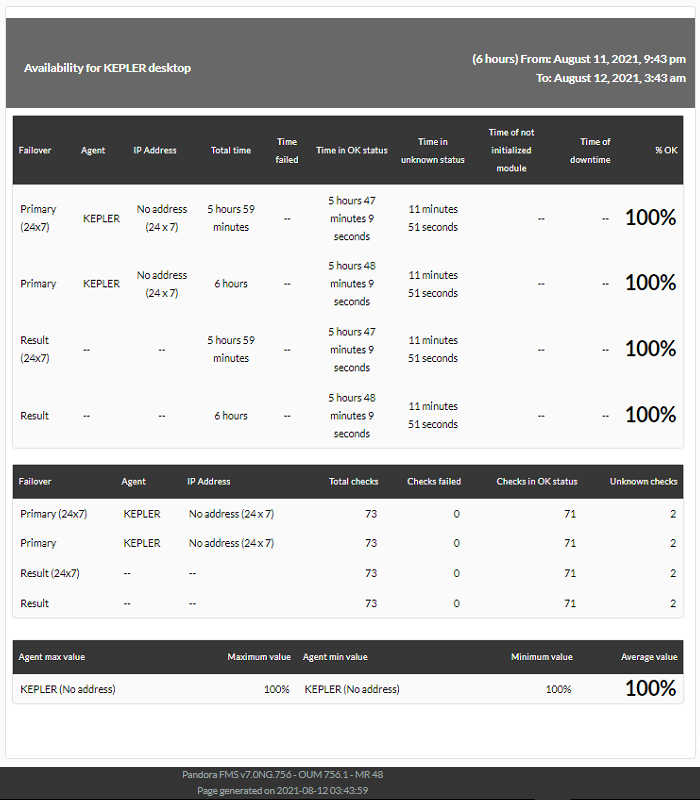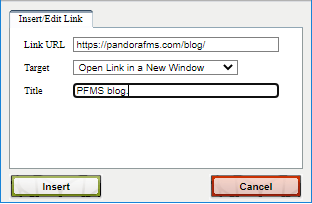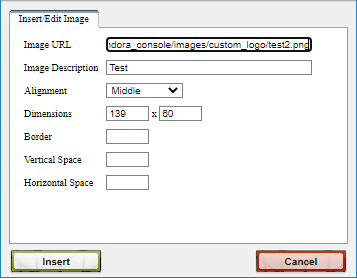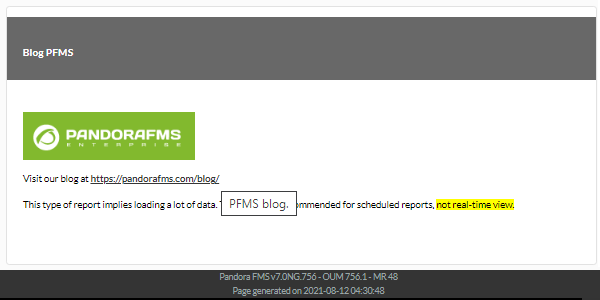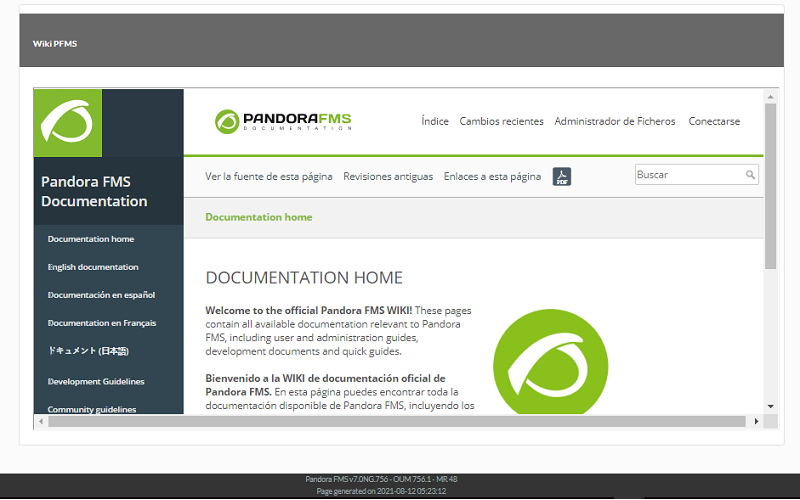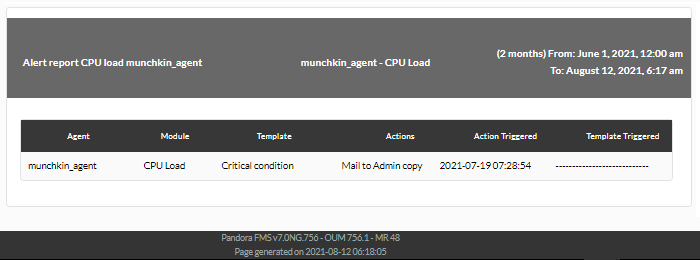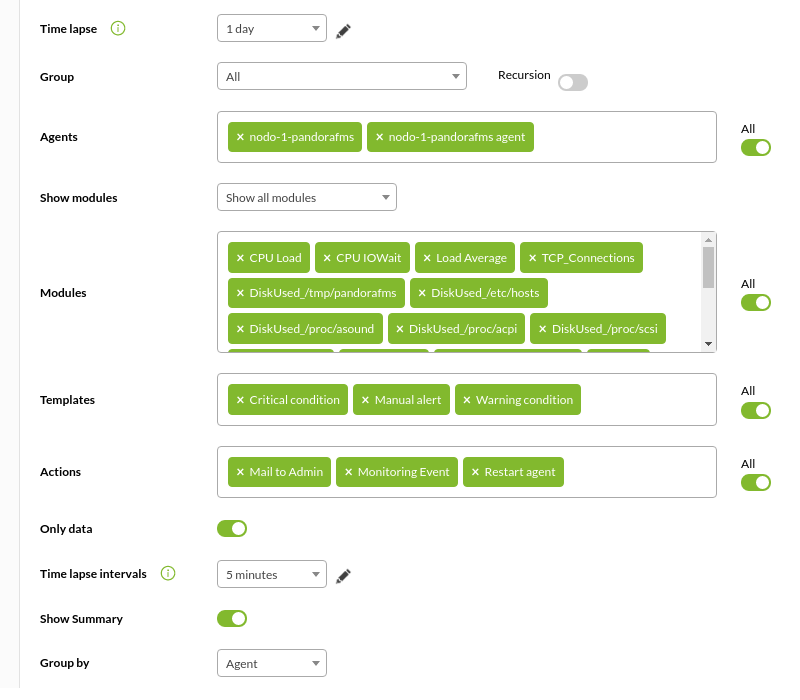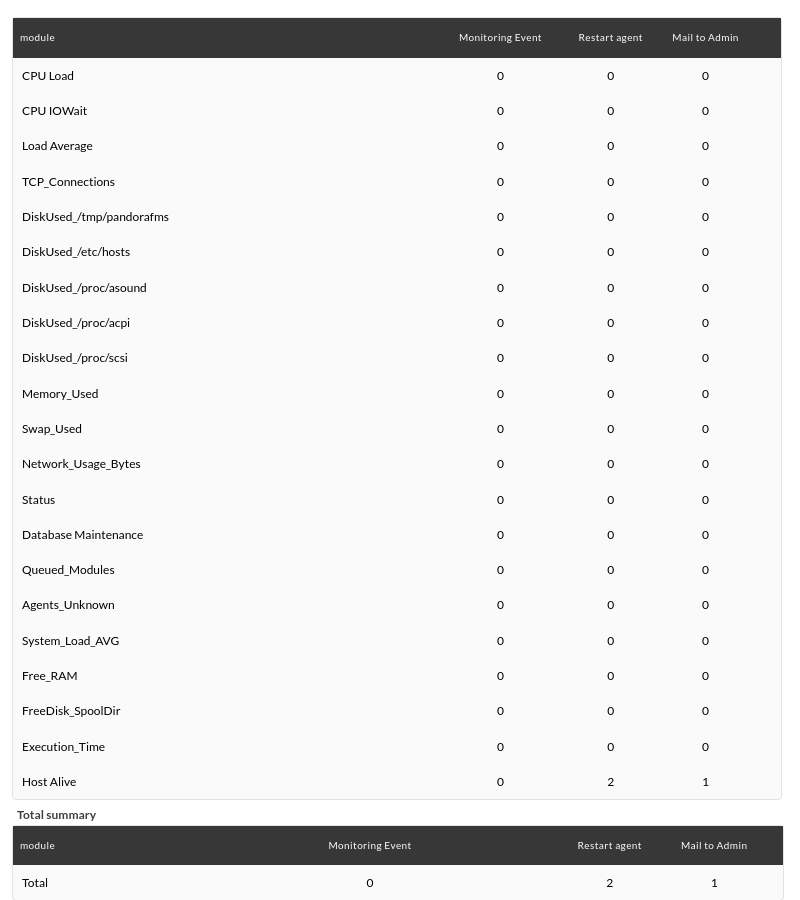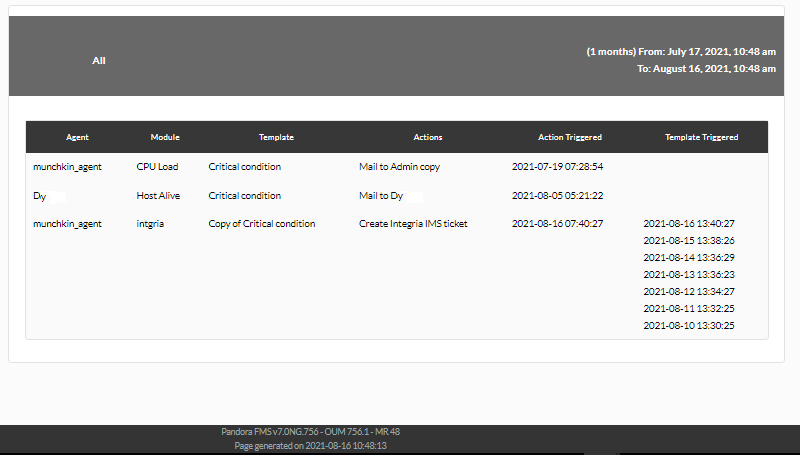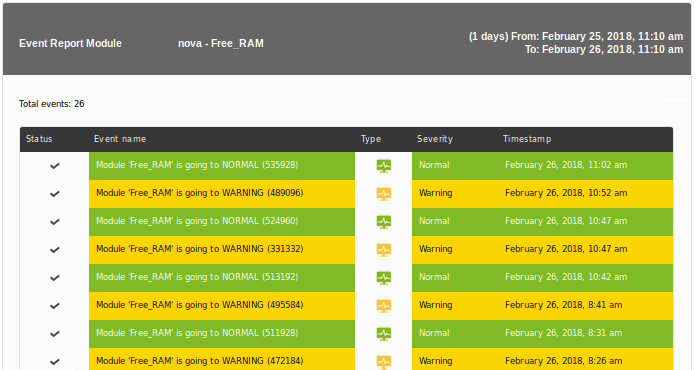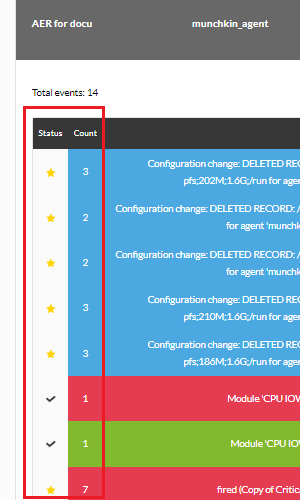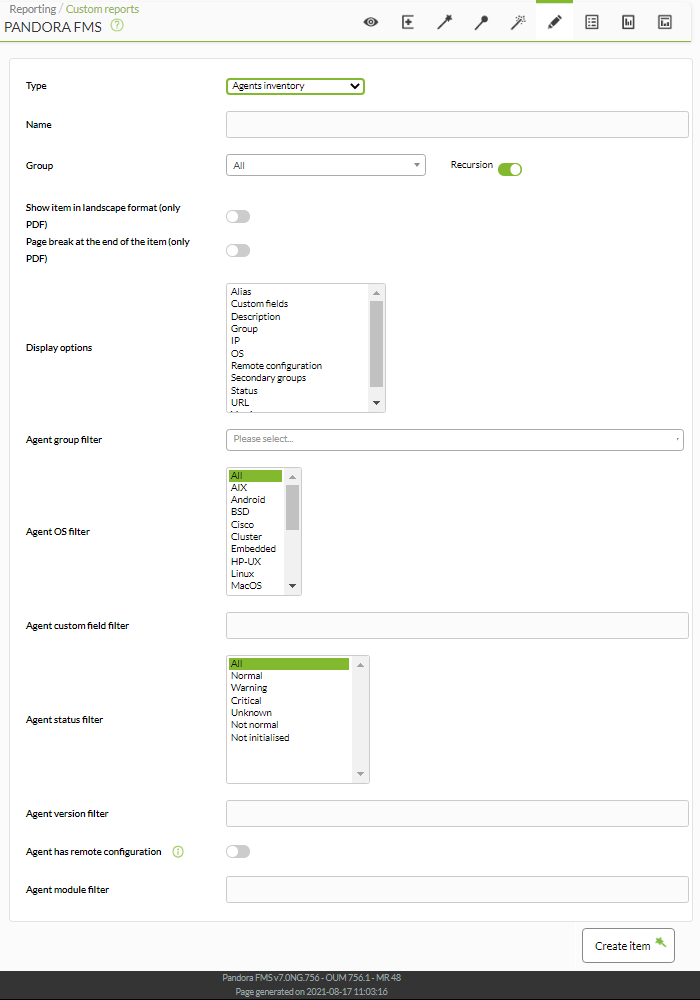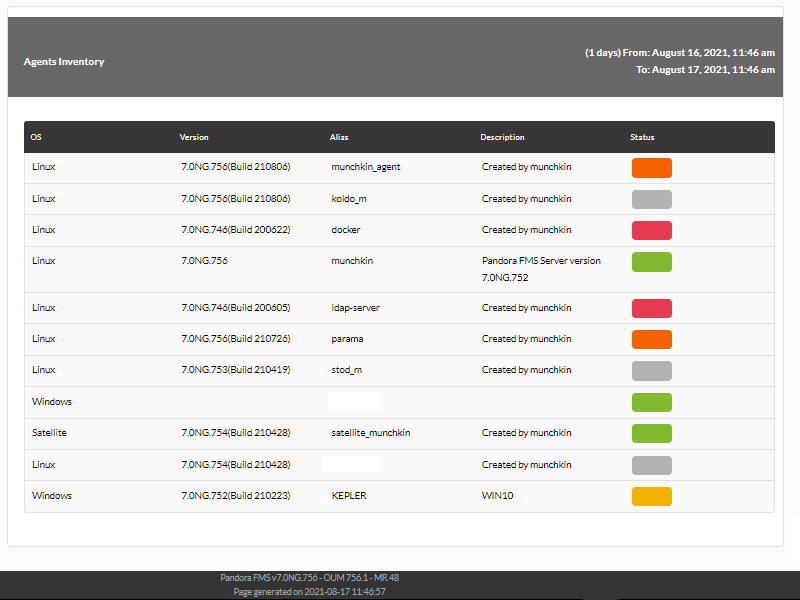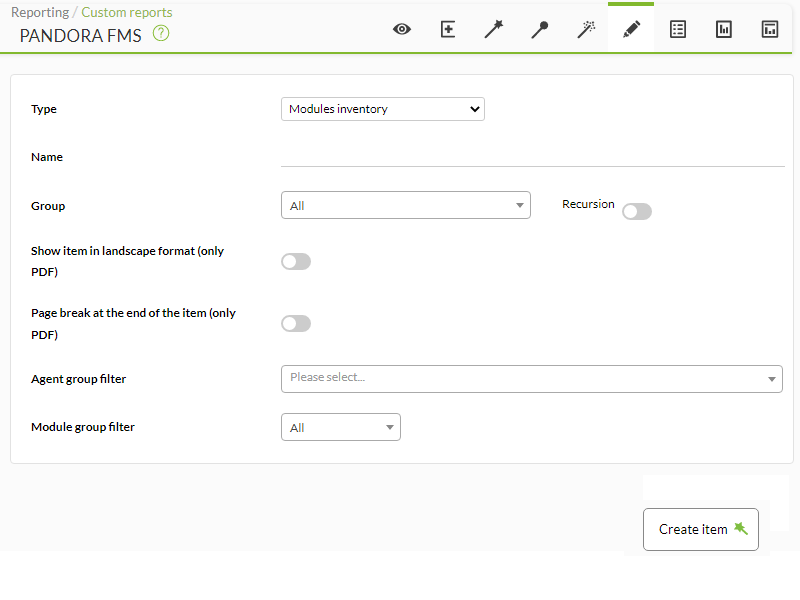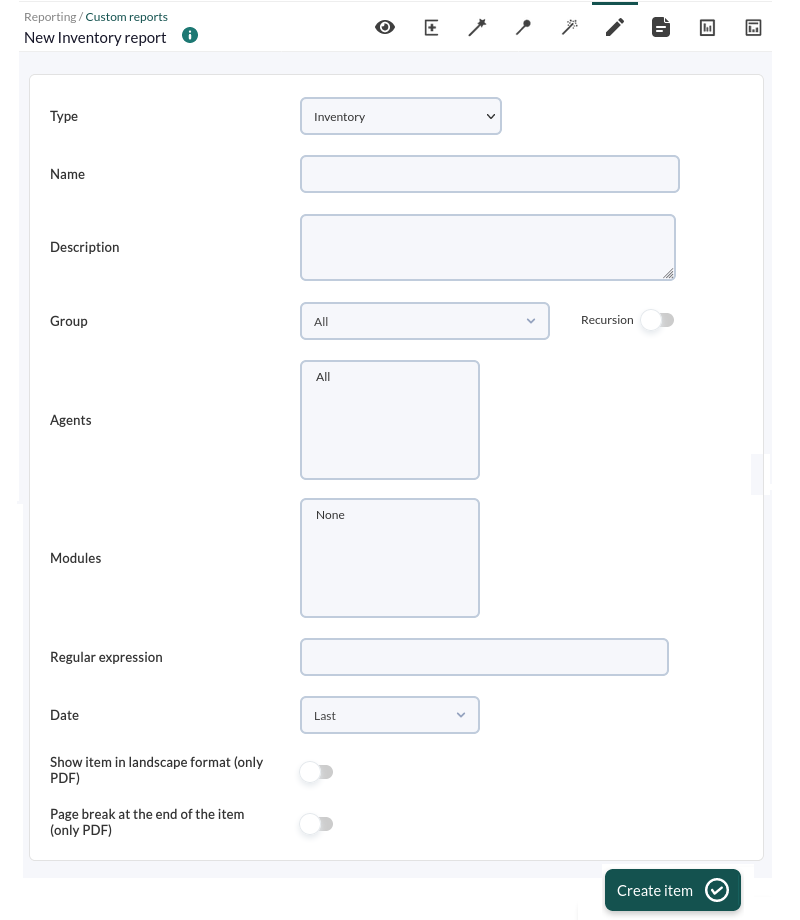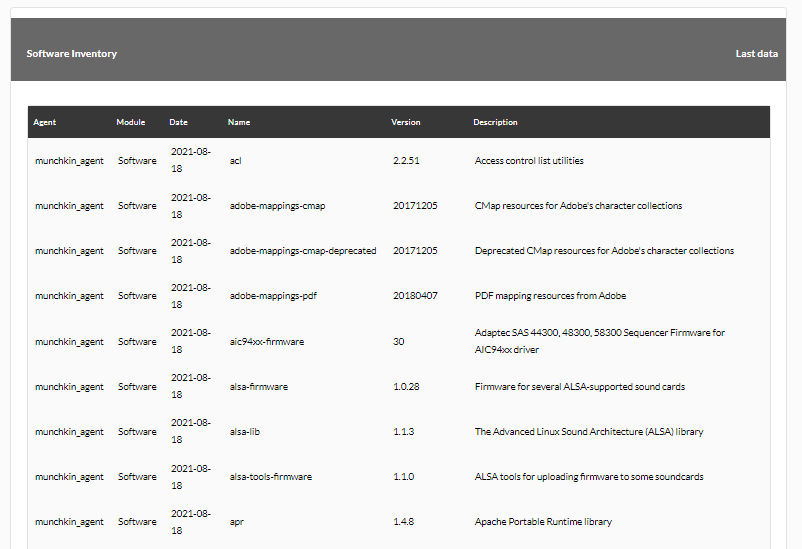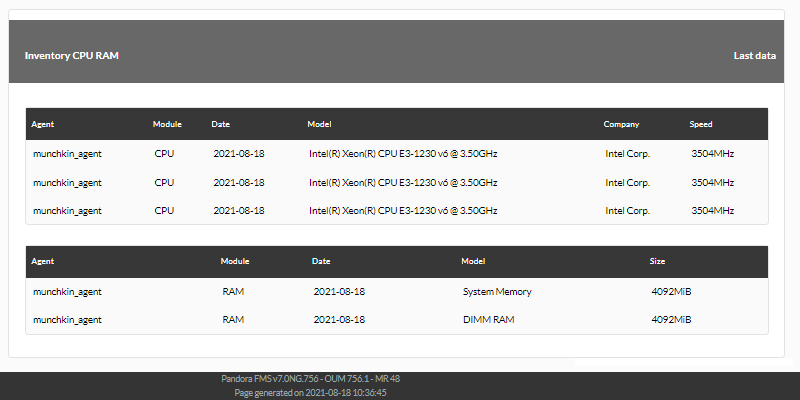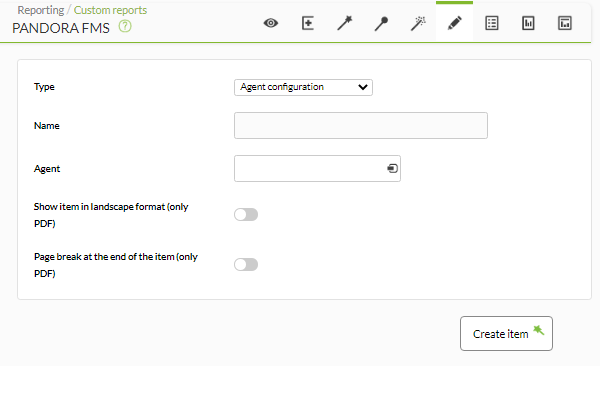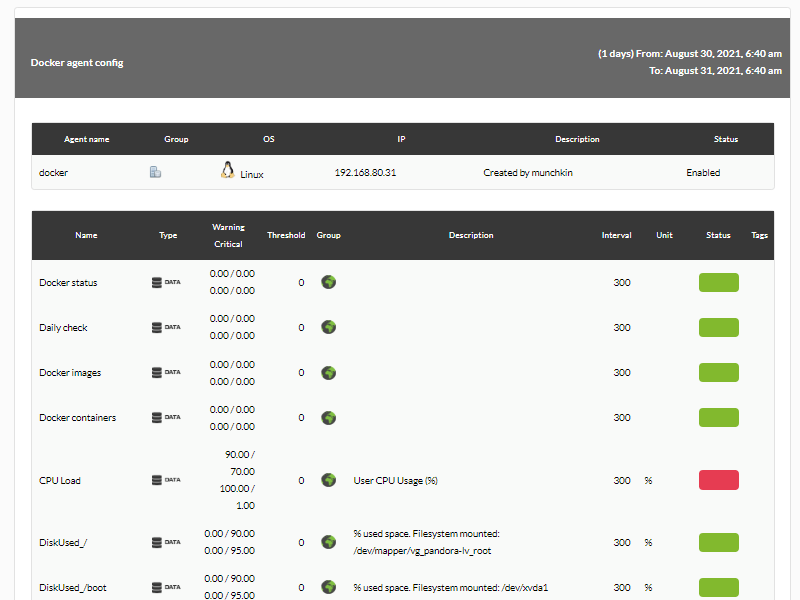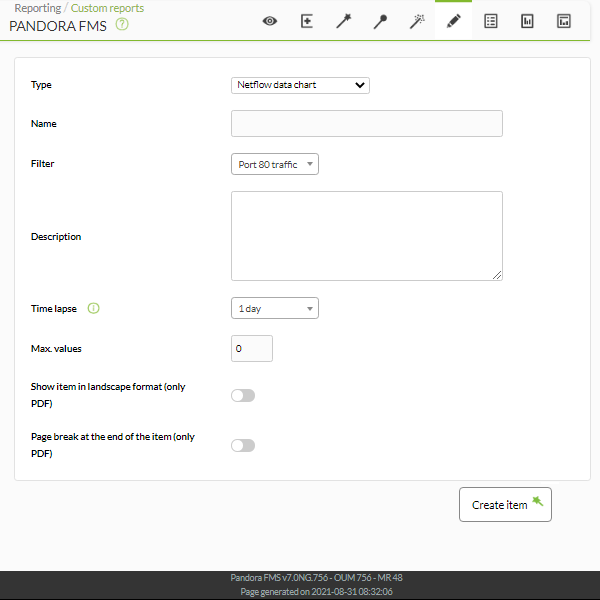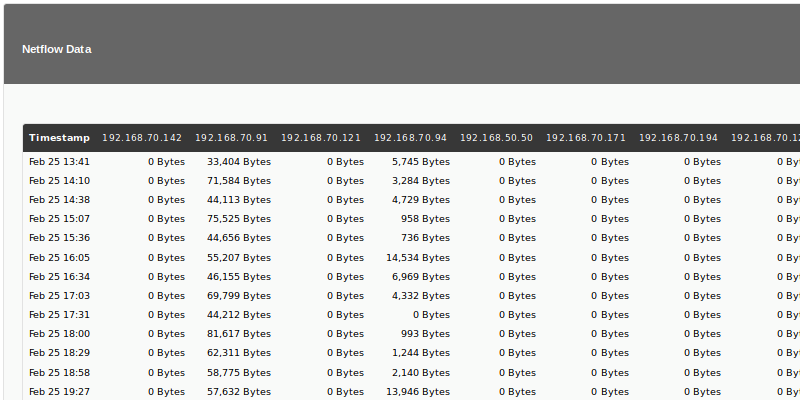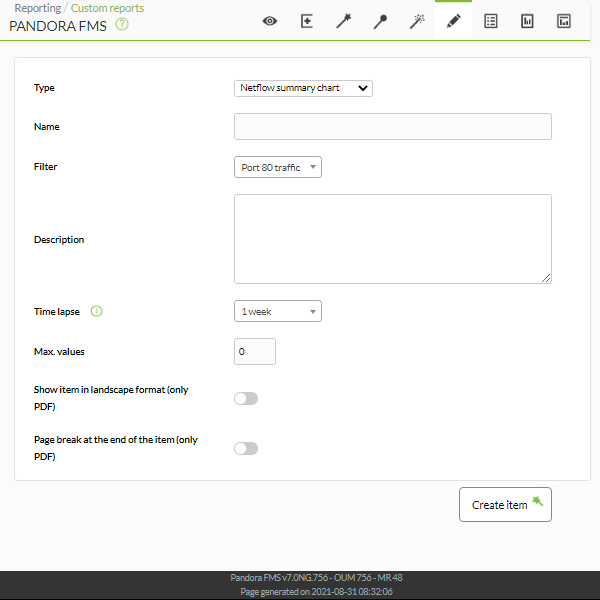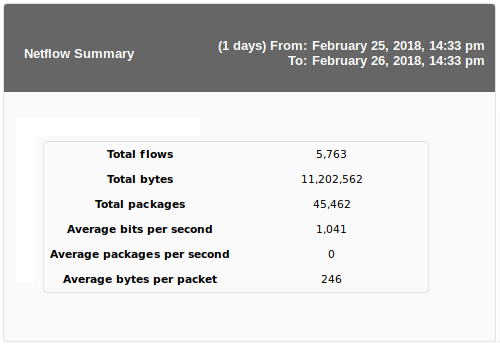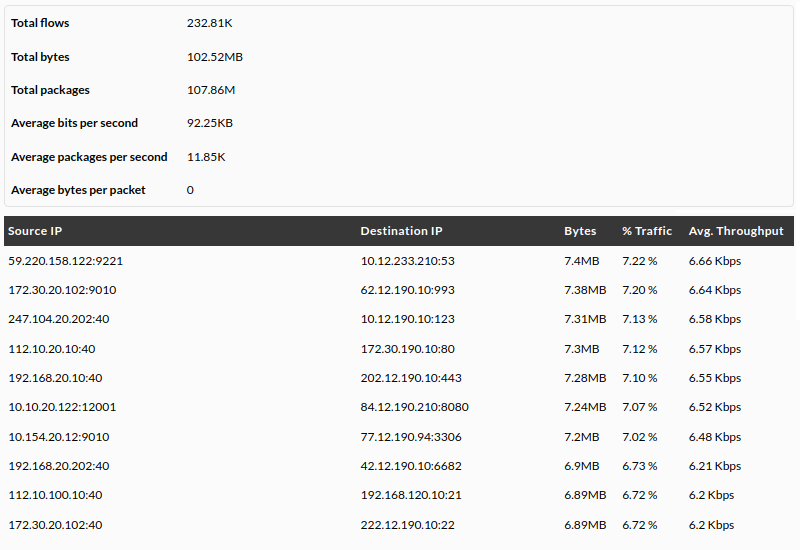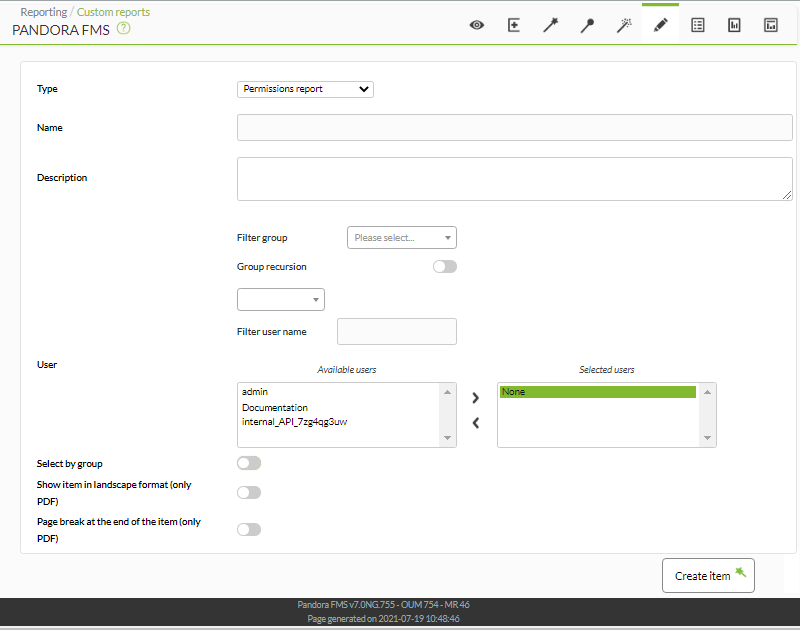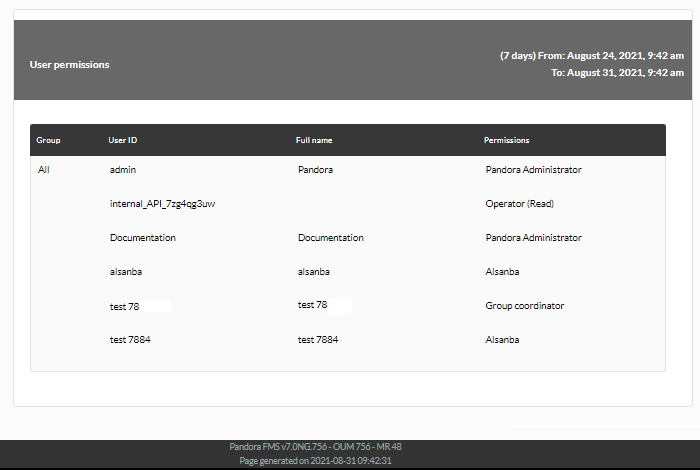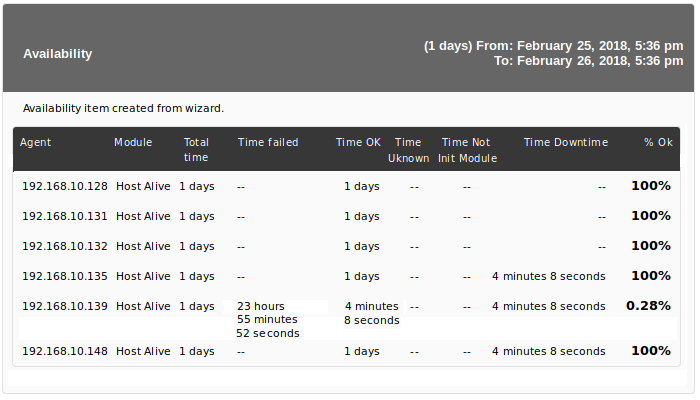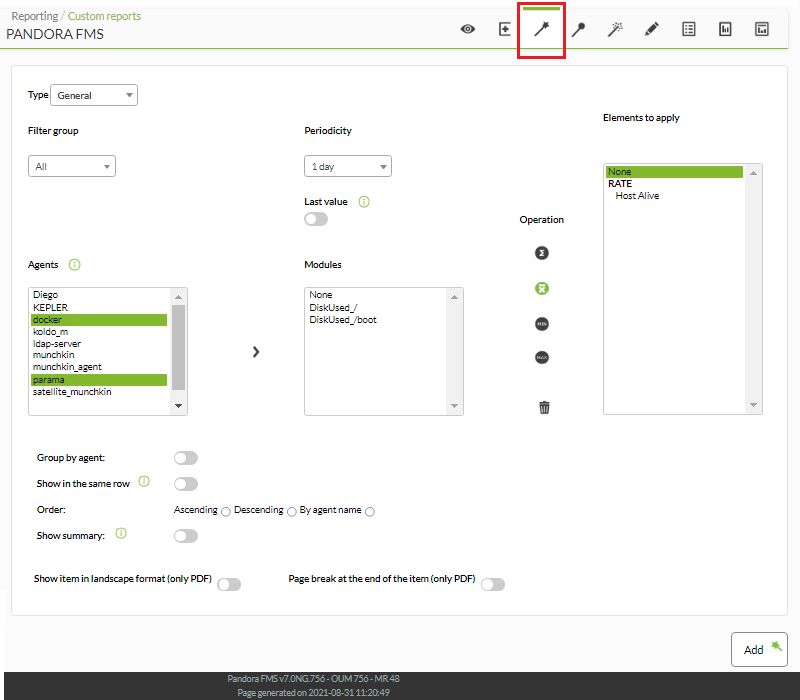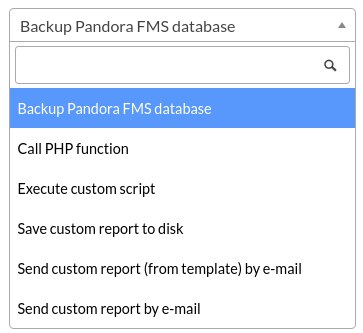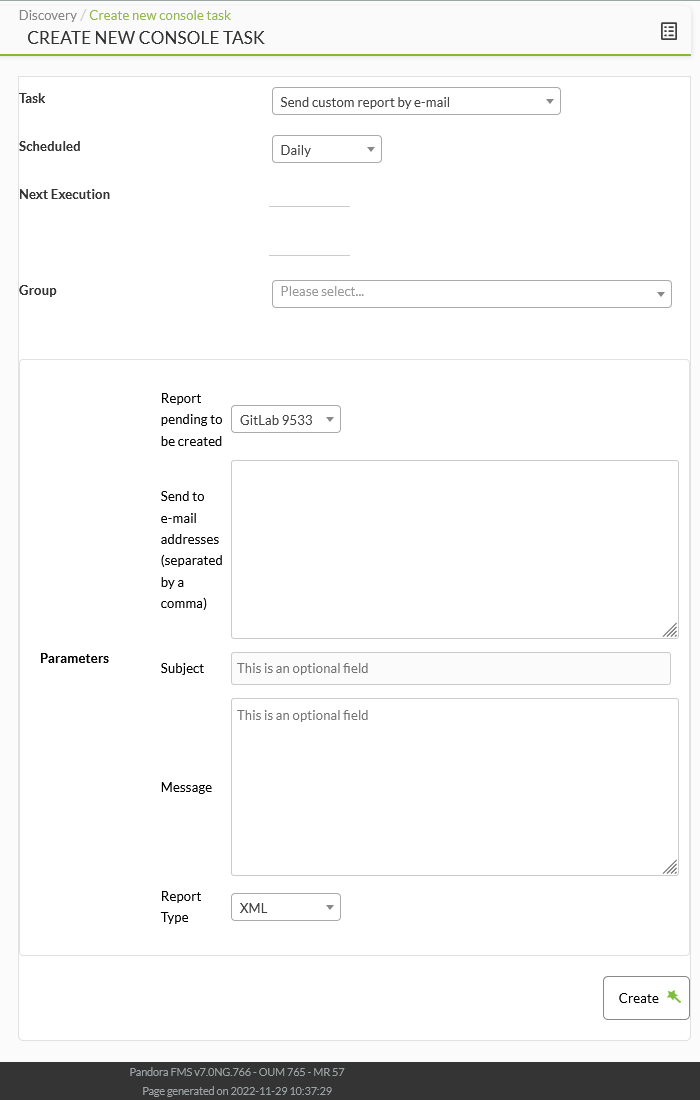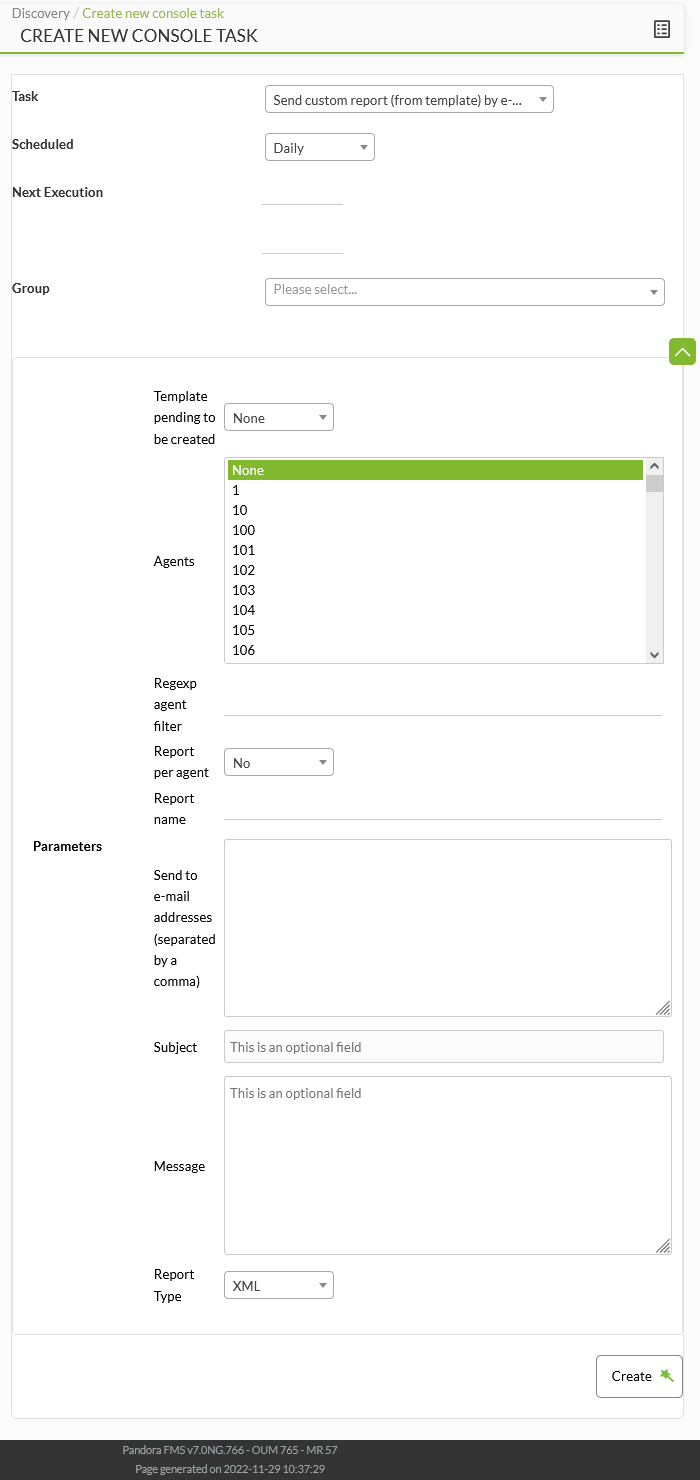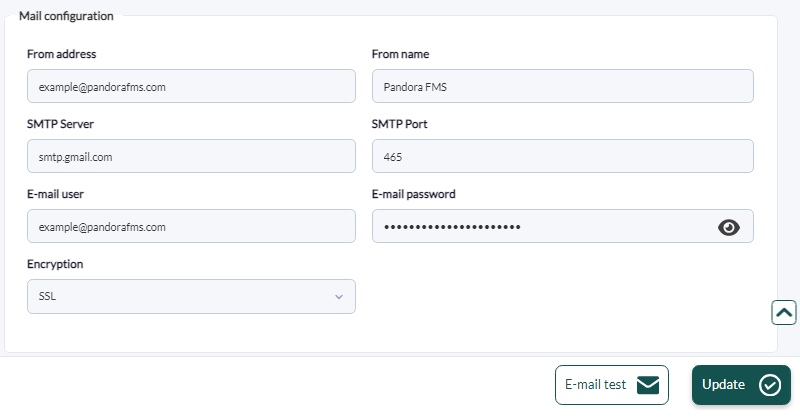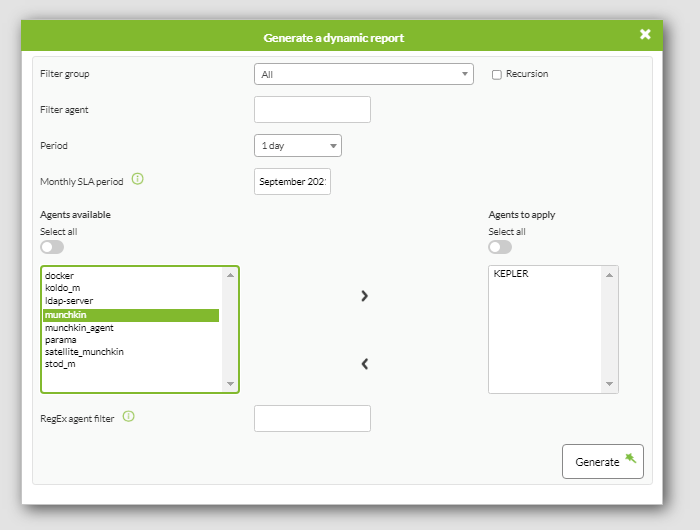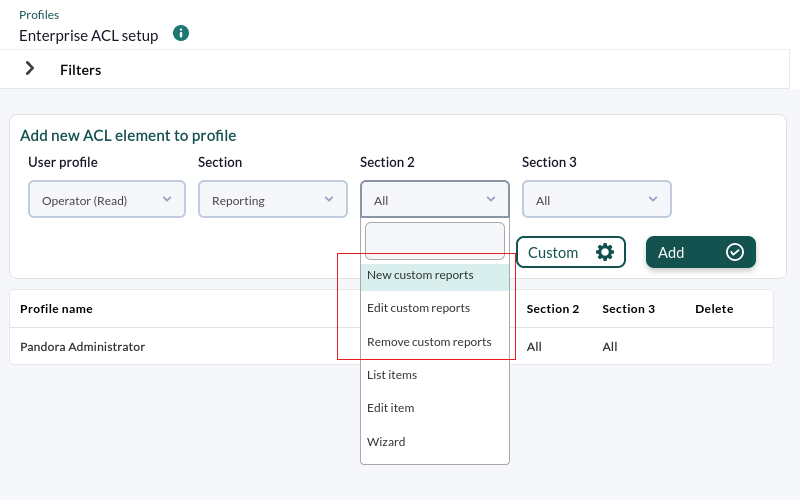Reports
Reports
![]() Pandora FMS offers you the possibility of presenting the monitored data sorted out through reports.
Pandora FMS offers you the possibility of presenting the monitored data sorted out through reports.
Within a report, the information to be presented is organized in report elements. There are many different types of elements, which perform calculations and present the information in very different ways. For instance, you may choose a “simple graph” type element that makes individual graphs or an SLA element (Service Level Agreement) that shows the degree of compliance of a number of monitors.

Although they generally have a very similar configuration form, each type of element will be configured independently. You may have as many elements as you need, from the type and style you wish.
Pandora FMS simplifies monitoring administration through user permissions. There are several permission systems that restrict what a user can see or manage, the most important is the concept of groups (either predefined groups by Pandora FMS and/or customized groups) combined with the profile of each user. Pay special attention to the notes about the All group (ALL) throughout the documentation.
![]() In version 771, or later, the “ACL Enterprise System” has specific options enabled for the administration and management of reports with customized user profiles to suit any need. For more details please refer to the “ACL Enterprise System focused on reports” section.
In version 771, or later, the “ACL Enterprise System” has specific options enabled for the administration and management of reports with customized user profiles to suit any need. For more details please refer to the “ACL Enterprise System focused on reports” section.
Creating a Report
In order to add a report, access Reporting → Custom reports.
It will show a list containing all the reports created. In order to create a report, click Create Report.
There is a form where to enter the Name of the report, select the Group it belongs to, whether it is private or not (Write access) and add its description.
In the Write access field you may choose the report editing rights:
- Only the group can edit the report : Only the group the report belongs to can be edited.
- Only the user and the admin user can edit the report : Only the author and an admin user may edit the report.
- The next group can edit the report : If that option is chosen, a list where you may choose any other group that could also edit the report will appear.
By default, the report will be interactive (checked as No in Non-interactive Report). When checking a report as non-interactive, it could also be sent by email:
By default it also has options activated to create a cover (Generate cover page in PDF render) and an index (Generate index in PDF render) when generating a PDF report from the report.
Once the necessary fields are filled out, click Save.
Once done, you will have an empty report and ready to add elements to it.
NG 770 version or later.
In the List of reports by clicking on the corresponding icon in the HTML column (except if the report is not interactive) you will be able to see the filters and the report itself on the screen. The report can be added (or removed) to your list of favorite reports (Favorite) by clicking on the star icon next to the report name.
Each report will be added, together with those already selected, to the Reporting section of the Favorite menu (Operation section).
Editing a report
Deleting a report
In order to delete a report, click on Reporting → Custom reports. Then click on the trash icon located at the right side of the report's name.
If there are several reports, in the Op column, click on the corresponding selection checkboxes and next use the Delete button.
Tabs
Main data tab
The Main data tab is the only one available within a new report, since there one defines the report's basic data. After saving it properly, you may access the rest of the tabs.
These fields are the same both for creating a report as well as for editing it.
Once you are done creating or editing, click Update to save field data.
List Items tab
In this tab you will have a global overview of all the items that make up the report. The items of the list will appear following the order of the report.
The columns this tab shows are:
- P. : Position elements will appear in in the report.
- Type: Column the type of items will appear in.
- Agent: Column where the Agent name will appear, it could be blank for item types such as SLA, Custom Graph, Import text from URL, SQL Query, Simple Graph and Text.
- Module: Column that shows the name of the Module data will be retrieved from to generate the report. It may be blank for item types such as Agent detailed view, Alert report agent, Custom Graph, Event report agent, Import text from URL, SLA, SQL query and Text.
- Period: Time interval based on which the report will be calculated (from that moment).
- Description: Column that shows the description of that item to make working on it easier.
- Options: Column “ Op.” that shws the buttons/icons to edit the item or delete it.
From the tab you may:
- Modify the item (clicking on the wrench icon).
- Modify the order (column “ P.”) through the selection checkboxes in the “Sort” column and the lower drop-down to Sort items.
- Modify the order automatically in the header cells with the white arrows, sorting alphabetically by element type, alphabetically by Agent name or alphabetically by Module name.
- Delete the item checking the selection checkbox in the “Op.” column and clicking “ Delete ” under the line list.
If it is an extensive report with multiple items, it has on top of a form to filter by different criteria.
Item editor tab
The Item Editor tab is more complex than the others, because there you will be able to create the form items or edit them. The form is dynamically designed, according to the type of item you intend to create. In the editing process, all fields except the type are editable.
If you need to change the type, the way to do it is to delete the current one and generate a new one along with the same configuration.
The common fields for all types are the following:
- Type: Drop-down with the item types for the report, which when choosing the type enables and disables fields necessary to configure it.
- Name: Report name. The following macros may be used:
_agent_: Name of the Agent you have selected in the report item._agentdescription_: Description of the Agent selected in the report item._agentgroup_: Agent group that selected the report item._address_: Address of the agent that selected the report item._module_: Name of the Agent Module that selected in the report item._moduledescription_: Description of the Agent Module selected in the report item.
- Description: Text box where to type in the report item.
- Show item in landscape format (only PDF).
- Page break at the end of the item (only PDF).
In the following example, a user located in America modifies an SLA item in a Pandora FMs server located in Europe:
Types of Items
The following items are available, divided into categories:
Graph Items
Simple graph
It displays the simple graph of a Module.
The fields of this form are:
- Name: Report name. The following macros can be used:
_agent_: Name of the Agent selected in the report item._agentdescription_: Description of the Agent selected in the report item._agentgroup_: Group of the Agent selected in the report item._address_: Address of the Agent selected in the report item._module_: Name of the Agent Module selected in the report item._moduledescription_: Description of the Agent Module selected in the report element.
- Label: Label that can be assigned to the element. The following macros can be used:
_agent_,_agentdescription_,_agentgroup_,_address_,_module_,_moduledescription_. - Time lapse: Time interval over which the report will be calculated (from the current time).
- Agent: The control to choose the Agent for this item, type in the first letters of the name and you will get a drop-down list.
- Module: Drop-down list that is dynamically loaded with the Modules of the Agent selected in the previous control.
- Graph render: Graphical representation, with options for Avg only, Max only, Min only, Avg max & min.
- Full resolution graph (TIP): Full resolution graphic (TIP), only for Avg only, Max only, Min only of the previous point
- Show threshold: Show thresholds, when this feature is activated they will be painted as backgrounds in different colors.
- Time comparison (overlapped): When enabled, it shows the graph of the module in that time frame overlapped on top. For example, if the graph shows a 1 month span, the graph overlapped above it is the previous month.
Example:
Simple baseline graph
With this chart you can see future values with estimates for the selected Module. For example, if you select a period of one week and today is Tuesday, you will see the actual data for Monday and Tuesday and estimates for the other days.
The fields of this form are:
- Name: Report name. The following macros can be used:
_agent_: Name of the Agent you have selected in the report item._agentdescription_: Description of the Agent you have selected in the report item._agentgroup_: Group of the Agent you have selected in the report item._address_: Address of the Agent you have selected in the report item._module_: Name of the Agent Module you have selected in the report item._moduledescription_: Description of the Agent Module you have selected in the report element.
- Label: Label that can be assigned to the element. The following macros can be used:
_agent_,_agentdescription_,_agentgroup_,_address_,_module_,_moduledescription_. - Time lapse: Time interval over which the report will be calculated (from the current time).
- Agent: The control to choose the Agent for this item, type the first letters of the name and you will get a drop-down list.
- Module: Drop-down list that is dynamically loaded with the Modules of the Agent selected in the previous control.
Example view of this type of report:
This type of graphs can overload Pandora FMS if a lot of data is used to make future estimations.
Custom graph
It is a user-defined combined graph (Custom graph). A field is added with a combo to select the graph intended to add.
 The fields within this form are the following:
The fields within this form are the following:
- Name: The following macros may be used:
_agent_: Name of the agent selected in report item._agentdescription_: Description of the agent selected in the report item._agentgroup_: Agent group selected in the report item._address_: Address of the agent selected in report item.-
_module_: Name of the module selected in report item. -
_moduledescription_: Description of the module selected in report item.
- Time lapse: The time interval on which the report is generated (from that moment).
- Custom Graph: A deployable list containing the user-defined graphs. In order to create theses graphs, click Create or do it from the menu Reporting → Custom graph → Create custom graph (Graph builder tool). If it exists and the defined graph needs to be edited, the use Edit.
An example view of this type of report:
Graphs defined from SQL
This type of items must be used with care as they can overload Pandora FMS excessively.
This type of report element allows custom graphs to be defined for use in reports.
- These graphs will be created using SQL code entered by the user.
- This SQL code should always return a variable called
labelfor the text labels or name of the elements to be displayed and a field calledvalueto store the numerical value to be represented. - This is an example of SQL used to create different types of graphs: horizontal bar graph, vertical bar graph and pie graph.
Due to security restrictions, there are some blocked words that cannot be used :
*, DELETE, DROP, ALTER, MODIFY, password, pass, INSERT and UPDATE
This is an SQL example used to create such graphs:
SELECT a.name as `label`, count(st.id_agente_modulo) as `value` FROM tagent_status st, tagent to WHERE a.id_agent = st.id_agent AND (unix_timestamp(now()) - st.utimestamp)> st.current_interval * 2 group by 1;
NG 765 version or later.
In SQL query, to delimit the report in both start and end date and time, you may use the _start_date_ and _end_date_ macros respectively. Example:
Then when requesting the report, check Set initial date to select the start date and time in From: and select the end date and time in to:, then click Update:
In another example, there is this graph displayed where the number of modules in unknown status per agent is shown:
- Name: Report name. The following macros may be used:
_agent_: Name of the agent selected in the report item._agentdescription_: Description of the agent selected in the report item._agentgroup_: Group of the agent selected in the report item._address_: Address of the agent selected in the report item._module_: Name of the agent module selected in the report element._moduledescription_: Description of the agent module selected in the report element.
- SQL query: Structured laguage query according to the conditions described above.
- Max items: Maximal amount of items to graph.
- Query History Database: It includes data older than 30 days stored in the history database. With this option selected, you may need more time to see the result.
SQL pie graph
Example of pie graph (SQL pie graph) for reports based on SQL queries.
SQL Vertical bar graph
Example of vertical bar graph (SQL Vertical bar graph) for reports based on SQL queries.
SQL horizontal bar graph
Example of horizontal bar graph (SQL horizontal bar graph) for reports based on SQL queries.
Availability graph
The availability report (Availability graph) shows in detail the reached status of a module in a given time interval.
It will indicate all the relevant information about the time that this module was available.
You may choose the time range you want for the report (for example, the last month) and the working time if for example you need to indicate that you are only interested in the state of your module in a certain schedule (for example, 8×5, from 8:00 to 16:00 from Monday to Friday).
From Pandora FMS version 749, these reports include also the possibility of checking the box 24×7, which is under the working time. That way, the information will be collected without taking into account the working time configuration and being able to compare both cases, since it will show 2 independent graphs.
It is also possible to determine a prioritization mode. When choosing the OK prioritization mode, if data in the SLA compliance range overlap in time and some other state (such as a scheduled downtime), that time range will be green. If the unknown prioritization mode option is chosen, the color corresponding to the other state will always be displayed.
After saving the report's element data, add the desired modules at the bottom:
Note: You may use the SLA min. and max. (value) to indicate that the calculations are made regarding the values reached by the module in that range. SLA limit % will indicate the acceptable minimum (within that range).
If you do not specify a minimum or maximum for the value, the threshold values defined in the module (dynamic limits) will be used by default.
When seeing the report, you will see the availability graph of the chosen module in the selected time range:
Failover mode
This feature is used to assign failover or backup modules to the main module on which the calculation of availability must be made. That is to say, if a module has one or several failover modules assigned, availability calculation for a specific time period will be done considering these modules.
When the measured main module falls, if there are one or several operative backup modules, these will be taken into account for SLA calculation. That way it shows only the real service failure where primary and backups do not work.
Add failover or backup modules:
It is done when editing the module availability calculation must be made on, in the Module relations section:
Select the module you wish to work as failover and select the type of relation that in this case is failover.
Once the modules are assigned in the report, enable the option “failover mode”:
There are two types of visual representation:
- Normal: It will show the graph of the main module, as well as all its failover or backup modules and the graph result.
- Simple: It will only show a graph that will be the result of the availability calculation of these modules.
In simple “availability graph” reports, add the possibility of adding a failover module directly to the report as a simulation, this one will work exactly the same as the previous ones.
This does not apply in the wizard or in template reports.
Module Histogram graph
It will show a graph (Module Histogram graph) with the status histogram of the chosen module.
Example of module definition:
Display example:
IPAM
IPAM networks
- Filter by network: Choose one of the networks created in the Operational View.
- Show alive IPs only: If activated, only IP addresses that are online will be displayed in the report.
- Show IPs not assigned to an agent: Allows you to choose whether or not the IP addresses are “orphaned”.
SLA items
All SLA reports show information about the fulfillment of a metric, that is, they indicate the percentage of time that the module has had a known valid value.
All SLAs understand as valid the unknown periods, since Pandora cannot guarantee the module status if it does not have module data. Also, all periods in planned stop are considered valid (since in a planned stop situation, it is assumed that the module situation is controlled and accepted) and periods in warning status (the service is still provided in a non-optimal state).
As it will be seen later, some of the SLA reports present data grouped by time periods and the general status of these periods is calculated. When dealing with long periods, the module the report is being made on may have gone through many states: unknown, planned stop… In these reports, there is a configuration parameter called prioritization mode that determines which states have preference when summarizing. There are two options:
- OK prioritization mode: The SLA compliance value prevails over the report non-run time, planned shutdowns, unknown time, and not started time.
- Unknown prioritization mode: Any value other than OK will prevail. That way, you will see the non-operation times of the report, planned stops, unknown time and not started even if there is some data that makes the SLA comply.
Of course, if at any time the SLA compliance value is not reached, it will be painted red in any of the modes.
SLA
It allows you to measure the Service Level Agreement (SLA) of any Pandora FMS monitor.
The fields belonging to this form are the following:
- Name: The following macros may be used:
_agent_: Name of the agent selected in report item.-
_agentdescription_: Description of the agent selected in the report item. -
_agentgroup_: Agent group selected in the report item. -
_address_: Address of the agent selected in report item. -
_module_: Name of the module selected in report item. -
_moduledescription_: Description of the module selected in report item.
- Time lapse: Time interval based on which the report willl be calculated (from that moment).
- Only display wrong SLAs: It only displays wrong SLAs.
- Work time: The time frame during which the SLA will be working. The graph will be fully shown, but it will only be calculated with the data within said working time frame. The SLA will be unknown (N/A) if the interval to be shown is out of the work interval. From Pandora FMS version 749, these reports include also the possibility of checking the box 24×7, which is under working time. That way, the information will be collected without taking into account the working time configuration and both cases may be compared, since it will show 2 separate graphs.
- Show graph: Select whether a SLA graph (Only graph), a status summary (Only table) or both elements will be shown (Chart&graph).
- Order: Order SLA items according to the chosen criteria.
Once these options have been selected, add each of the target modules based on which the SLA must be calculated:
- Agent: A combo box intended to select the agent to use in the SLA.
- Module: A combo box intended to select the module to use in the SLA.
- SLA min (value): A field intended to determine the SLA's minimum value. The minimum values will trigger the SLA. This field can be empty to use the acceptable minimum module normal values.
- SLA max (value): An optional field intended to determine the SLA's maximum value. The maximum values will also trigger the SLA. It can be empty to use the acceptable maximum module normal values.
- SLA Limit (%): A field intended to set the correct time percentage for the SLA. If the module has been within the minimum and maximum limit values during this particular time percentage, the SLA will be shown as correct and as wrong if not.
It is also possible to add new modules to the SLA to create combined-module SLAs from the same or different systems.
In case of combined SLAs, SLA compliance will depend heavily on the performance of all the SLAs configured so far.
The SLA value will take into account only the critical status of the selected module and they will be labeled as valid.
- Time in unknown.
- Time in scheduled downtime
- Time in warning status.
- Time in OK status.
Why accept unknowns?
Unknown status is reached when Pandora FMS does not receive information from a certain target. In this situation, Pandora FMS cannot guarantee whether the service was provided as usual or not, so in the face of an unknown it is accepted.
When taking into account the SLA calculation shown in the report, you may configure scheduled downtimes (past or future) so that it does not take into account possible failures that could possibly take place during that interval of the scheduled downtimes. The value it will take in all the intervals where the scheduled downtimes is enabled is OK, as if during that intervals no incorrect data was received.
In this example it can be seen better. In the first image, there is a module data history with two intervals in critical status. Without scheduled downtime the SLA value is 93%.
After seeing that the first module downfall was due to external problems, a scheduled task that covers that interval is added. When adding the scheduled task, the final estimation will take it as if the module's status was correct all along.
Note: If you forgot to create a scheduled downtime, you may create past scheduled downtimes given that the console administrator has enabled it.
Monthly SLA
This feature is only available for Pandora FMS Enterprise versions. It is a variation of the SLA feature. Instead of measuring the service level periodically, it does it every day during the months in this period.
Examples:
- In a report of May 5th, it will calculate the SLA of every day in May.
- In a report between February 13th and April 4th, it will calculate the SLA of every day in February, March and April.
Each module on each month will contain the same data of a standard SLA, except that its compliance will not be at month level. It will be the percentage of days that accomplish it. There is also a bar that will display all days of the month by the following color code:
- Green: The SLA met.
- Red: The SLA met.
- Gray: Unknown. There is not enough data on that day.
Days in unknown will be taken into account as valid data for the percentage of days that meet the SLA.
If there are days that do not meet the SLA, they will be detailed in a summary table.
Weekly SLA
It displays the SLA of the modules chosen by weeks along the selected period (current month by default, it can be deactivated with Current month selector).
It allows to edit the working time in case you have a custom service schedule (e.g. 8×5) At the bottom, you may add multiple modules to this item.
View example:
Hourly SLA
It displays the SLA of the modules chosen by hour along the selected period (current month by defaultt, it can be deactivated with Current month selector).
It allows to edit the working time in case you have a custom service schedule (e.g. 8×5). At the bottom, you may add multiple modules to this item.
View example:
Service SLA
It allows to measure the Service Level Agreement of any service created in Pandora FMS
The fields found in this particular form are the following:
- Name: The following macros may be used:
_agent_: Name of the agent selected in report item.-
_agentdescription_: Description of the agent selected in the report item. -
_agentgroup_: Agent group selected in the report item. -
_address_: Address of the agent selected in report item. -
_module_: Name of the module selected in report item. -
_moduledescription_: Description of the module selected in report item.
- Time lapse: Time interval based on which the report willl be calculated (from that moment).
- Working Time: Time to be taken into account for SLA calculation (e.g. for working schedules like 8×5).
Since Pandora FMS services come with their own SLA readings, calculations for the report are different according to the standard performance.
In this case, you may only choose the service whose SLA you wish to receive from those services you have configured in your Pandora FMS console. The SLA validity limit values are recovered automatically from the definition of the service itself.
You may always set planned downtimes to adjust the compliance levels whenever you need so, so that possible downfalls are not taken into account.
These scheduled downtimes may be assigned to the modules that make the service whose report you wish to obtain, or its sub-services. In all intervals affected by downtimes, the states that the service could have reached will be overlooked, and that period will not be taken into account for the the final SLA calculation.
In this example, you may see an outline of the final calculation of the service, depending on the scheduled downtimes (orange) and the critical states (red) of the modules on which the state of the final service for SLA calculation depends.
Looking at the image, when any of the modules have a downtime that directly affects the final service and this interval is omitted for final calculation.
Prediction Items
Prediction Date
This type of item returns the date when module reaches its interval using a data projection of a module to the future.
To calculate it, use the method of the minimal squares.
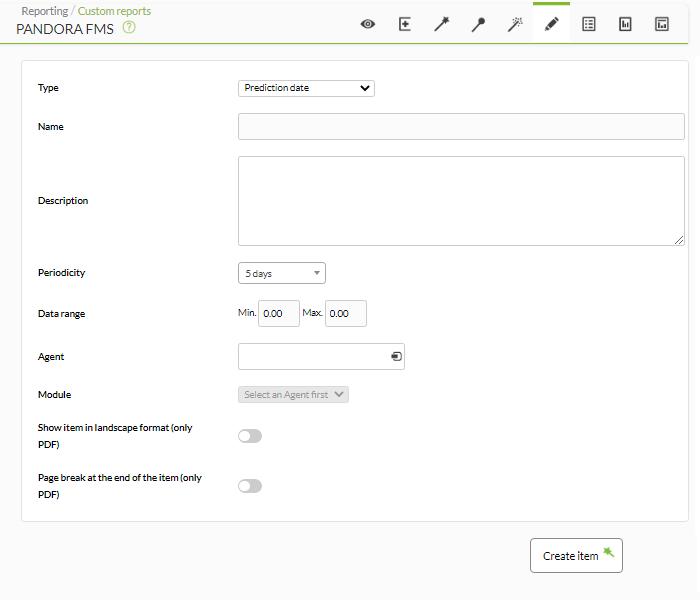 To configure this type of item, the following data must be provided:
To configure this type of item, the following data must be provided:
- Name: The following macros may be used:
- _agent_ : Name of the agent selected in report item.
- _agentdescription_ : Description of the agent selected in report item.
- _agentgroup_ : Group of the agent selected in report item.
- _address_ : Address of the agent selected in report item.
- _module_ : Name of the module name selected in report item.
- _moduledescription_ : Description of the module that you selected in report item.
- Periodicity: The time period that works as basis for the estimation.
- Data Range: The interval where module data must be to return the date.
- Agent: The control to choose the agent for this item, type in the first letter of the name and you will get a drop-down list.
- Module: Drop-down list loaded dynamically with the modules of the selected agent in the previous control.
For instance, to check when a disk usage value between 60 and 100% for the mounting point /var will be reached, the following definition is used.
That will generate the following output in this case:
Projection Graph
This type of item allows to assess the values a module will take in the future.
This estimation is based on a linear regression, implemented following the method of least squares.
Configure the following parameters accurately to get relevant results: The fields in this form are:
- Name: The following macros may be used:
- _agent_ : Name of the agent selected in report item.
- _agentdescription_ : Description of the agent selected in report item.
- _agentgroup_ : Group of the agent selected in report item.
- _address_ : Address of the agent selected in report item.
- _module_ : Module name that you selected in report item.
- _moduledescription_ : Description of the agent module selected in report item.
- Periodicity: The time period taken as basis for the estimation.
- Projected Period: The future time period where data will be projected.
- Agent: The control to choose the item for this module, type in the first letters of the name and you will obtain a drop-down list.
- Module: Drop-down list loaded dynamically with the Modules of the agent selected in the previous control.
In the example image, the area name period represents the evolution of module data during the selected time interval.
On the other hand, projection period shows the possible evolution of the module along the selected time.
A definition example, complementary to the previous case is the evolution of the usage of the disk mounted on /var.
Obtaining the following results:
Module Items
Avg. Value
It is the average value for a module within a predefined period. This period is calculated when viewing the report.
The fields of this form are the following:
- Name: Report name. The following macros may be used:
_agent_: Name of the agent selected in report item._agentdescription_: Description of the agent selected in report item._agentgroup_: Group of the agent selected in report item._address_: Address of the agent selected in report item._module_: Name of the agent module selected in report item._moduledescription_: Description of the module selected in report item.
- Label: Tag that may be assigned to the element. The following macros may be used:
_agent_,_agentdescription_,_agentgroup_,_address_,_module_,_moduledescription_. - Time lapse: The time period taken backwards from the time point when the report is generated.
- Agent: The control to choose the appropriate agent for this item, type in the first name letters and you will get a drop-down list.
- Module: Drop-down list dynamically loaded with the agent's modules selected in the previous control.
- Calculate for custom intervals: It shows the average data in custom intervals. By enabling this option, the following fields will be enabled too:
- Time lapse intervals: Time lapse intervals the period is divided into for more precise calculations.
- Table only / Graph only / Graph and table: Show table, graph or both.
- Use prefix notation: Use prefix notation for numerical values (example: 20.8 Kbytes/sec), otherwise the full value will be displayed (example: 20742 bytes/sec).
Within the HTML report version, an this type of item is generated as seen below.
Max. Value
It is the maximum value (Max Value) of a module within a predefined period. This period is calculated at the report's display.
- Name: Report name. The following macros may be used:
_agent_: Name of the agent selected in report item._agentdescription_: Description of the agent selected in report item._agentgroup_: Group of the agent selected in report item._address_: Address of the agent selected in report item._module_: Name of the agent module selected in report item._moduledescription_: Description of the module selected in report item.
- Label: Label the can be assigned to an element. The following macros may be used:
_agent_,_agentdescription_,_agentgroup_,_address_,_module_,_moduledescription_. - Time lapse: The time frame taken backwards from the time point when the report is generated.
- Agent: A control to select the appropriate agent for the item. Type in the first letters of the name and you will get a deployable list.
- Module: A deployable list dynamically loaded with the agent's modules selected in the previous control.
- Calculate for custom intervals: Show average data throughout custom intervals. By enabling this option the following fields will be enabled:
- Time lapse intervals: Time lapse the period is divided into for more precise calculations.
- Table only / Graph only / Graph and table: Show a graph, a table or both.
- Use prefix notation: Use prefix notation for numeric values (example: 20.8 Kbytes/sec), otherwise the full value will be displayed (example: 20742 bytes/sec).
Display example:
Min. Value
The minimum value (Min. Value) of a module within a predefined period. This period is calculated right when the report is displayed.
- Name: Report name. The following macros may be used:
_agent_: Name of the agent selected in report item._agentdescription_: Description of the agent selected in report item._agentgroup_: Group of the agent selected in report item._address_: Address of the agent selected in report item._module_: Name of the agent module selected in report item._moduledescription_: Description of the agent module selected in report item.
- Label: Label an element can be assigned. The following macros may be used:
_agent_,_agentdescription_,_agentgroup_,_address_,_module_,_moduledescription_. - Time lapse: Time interval taken backwards from the point the report is generated.
- Agent: A control for selecting the appropriate agent for this item. Type in the first letters of the name and you will obtain a drop-down list.
- Module: Drop-down list dynamically loaded by the agent's modules selected in the previous control.
- Calculate for custom intervals: Show average data throughout custom intervals. By enabling this option the following fields will be enabled.
- Time lapse intervals: Time lapse intervals the period is divided into for more precise calculations.
- Table only / Graph only / Graph and table: Show a table, a graph or both.
- Use prefix notation: Use prefix notation for numeric values (example: 20.8 Kbytes/sec), otherwise the full value will be displayed (example: 20742 bytes/sec).
Viewing example:
Monitor Report
It shows the percentage of time that a module has been in normal state or another of its states, as warning or critical, in the defined period of time.
The fields of this form are the following:
- Name: The following macros may be used:
- _agent_ : Name of the agent selected in report item.
- _agentdescription_ : Description of the agent selected in report item.
- _agentgroup_ : Group of the agent selected in the report item.
- _address_ : Address of the agent selected in report item.
- _module_ : Name of the agent module selected in report item.
- _moduledescription_ : Description of the agent module selected in report item.
- Time lapse: Time interval taken based on which the report is calculated (from the present moment).
- Agent: An intelligent control for selecting the appropriate agent for this item.
- Module: Drop-down list which is dynamically loaded by the agent's modules selected in the previous control.
- Label: Label an element can be assigned. The following macros may be used: _agent_, _agentdescription_, _agentgroup_, _address_, _module_, _moduledescription_.
Within the HTML version of the report, an item of this type is generated as you may see below.
Serialize Data
It displays an item in table format report from the data stored within the table named tagente_datos_string the Pandora FMS Database. For it, the agent should serialize the data separating them with a line-separating character and another which separates the fields. All lines should contain all fields.
This type of item, for instance, is used for the agent that retrieves management data from the SAP platform.
The fields of this form are the following:
- Name: The following macros may be used:
- _agent_ : Name of the agent selected in report item.
- _agentdescription_ : Description of the agent selected in report item.
- _agentgroup_ : Group of the agent selected in the report item.
- _address_ : Address of the agent selected in report item.
- _module_ : Name of the agent module selected in report item.
- _moduledescription_ : Description of the agent module selected in report item.
- Time lapse: Time interval taken based on which the report is calculated (from the present moment).
- Agent: An intelligent control for selecting the appropriate agent for this item.
- Module: Drop-down list which is dynamically loaded by the agent's modules selected in the previous control.
- Serialized Header: A text field where the table headers shown in the report are separated by the '|' (pipe) character. There is one for each column created when separating the assembled field.
- Field Separator: A separator intended for different fields within the serialized text chain.
- Line Separator: A separator intended for different lines (made up by different fields) of the serialized text strings.
- Label: Label assigned to an element. The following macros may be used: _agent_, _agentdescription_, _agentgroup_, _address_, _module_, _moduledescription_.
The module that generates the following report returns lines with the following content:
Some text sample|some value#this is a new row|and another value
When generating a report from that content, the output is the following:
Summation
It displays the Sum of a module's values within a specific time frame.
- Name: The following macros may be used:
_agent_: Name of the agent selected in the report item._agentdescription_: Description of the agent selected in the report item._agentgroup_: Group of the agent selected in the report item._address_: Address of the agent selected in the report item._module_: Name of the agent module selected in the report item._moduledescription_: Description of the agent module selected in the report item.
- Label: Label an element can be assigned. The following macros may be used:
_agent_,_agentdescription_,_agentgroup_,_address_,_module_,_moduledescription_. - Time lapse: Time interval taken based on which the report is calculated (from the current time).
- Agent: The control for selecting the appropriate agent for this item. Type in the first letters of the name and you will obtain a drop-down list.
- Module: Drop-down list dynamically loaded by the agent's modules selected in the previous control.
- Use prefix notation: Use prefix notation for numeric values (example: 20.8 Kbytes/sec), otherwise the full value will be displayed (example: 20742 bytes/sec)
- Uncompress module: For using data from uncompressed modules.
This is a display example:
History Data
This type of element will receive a dump of the stored data of the module stored for more than 30 days indicated in the configuration of the report.
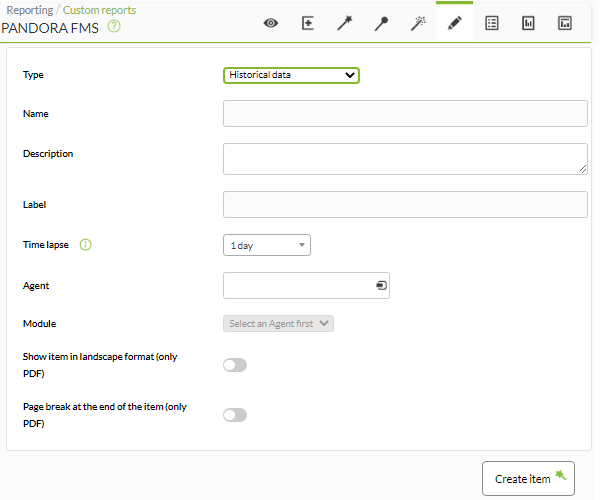
- Name: The following macros may be used:
- _agent_ : Name of the agent selected in report item.
- _agentdescription_ : Description of the agent selected in report item.
- _agentgroup_ : Group of the agent selected in the report item.
- _address_ : Address of the agent selected in report item.
- _module_ : Name of the agent module selected in report item.
- _moduledescription_ : Description of the agent module selected in report item.
- Time lapse: Time interval taken based on which the report is calculated (from the present moment).
- Agent: An intelligent control for selecting the appropriate agent for this item.
- Module: Drop-down list which is dynamically loaded by the agent's modules selected in the previous control.
- Label: Label an element can be assigned. The following macros may be used: _agent_, _agentdescription_, _agentgroup_, _address_, _module_, _moduledescription_.
Example of report display:
Increment
This type of report element is used to show a brief analysis where the value variation of the indicated module is detailed.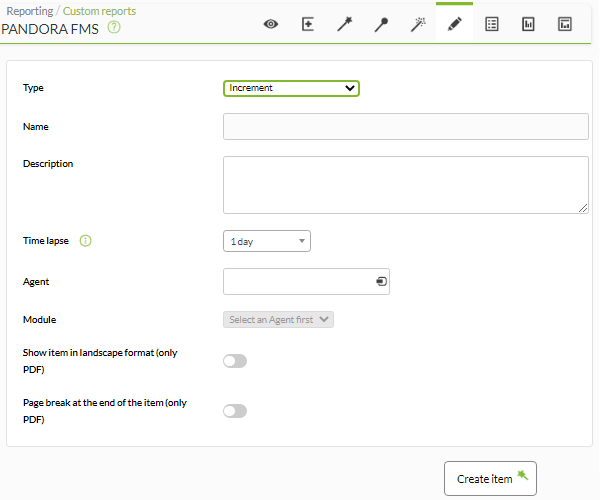
Configure the following fields:
- Name: The following macros may be used:
- _agent_ : Name of the agent selected in report item.
- _agentdescription_ : Description of the agent selected in report item.
- _agentgroup_ : Group of the agent selected in the report item.
- _address_ : Address of the agent selected in report item.
- _module_ : Name of the agent module selected in report item.
- _moduledescription_ : Description of the agent module selected in report item.
- Time lapse: Time interval taken based on which the report is calculated (from the present moment).
- Agent: An intelligent control for selecting the appropriate agent for this item.
- Module: Drop-down list which is dynamically loaded by the agent's modules selected in the previous control.
Example of report display:
Last Value
It is the last value for a module within a predefined period. This period is calculated when viewing the report.
- Name: The following macros may be used:
- _agent_ : Name of the agent selected in report item.
- _agentdescription_ : Description of the agent selected in report item.
- _agentgroup_ : Group of the agent selected in report item.
- _address_ : Address of the agent selected in report item.
- _module_ : Name of the agent module selected in report item.
- _moduledescription_ : Description of the module selected in report item.
- Agent: The intelligent control to choose the appropriate agent for this item.
- Module: A drop-down list which is dynamically loaded with the agent's modules selected in the previous control.
Within the HTML version of the report, an item of this type is generated as seen below.
Grouped Items
General
It shows values from different modules sorted (ascendingly, descendingly or by agent name) or/and grouped by agent.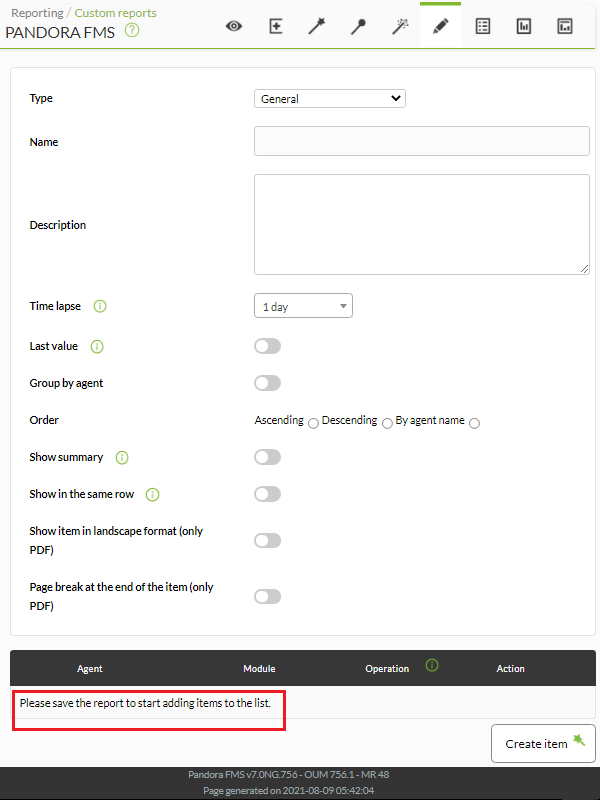
- Name: The following macros may be used:
- _agent_ : Name of the agent selected in report item.
- _agentdescription_ : Description of the agent selected in report item.
- _agentgroup_ : Group of the agent selected in the report item.
- _address_ : Address of the agent selected in report item.
- _module_ : Name of the agent module selected in report item.
- _moduledescription_ : Description of the agent module selected in report item.
- Time lapse: Interval of time on which the report will be calculated (from the current moment).
- Last value: Show only the last reading of the chosen modules.
Reports in period 0 cannot show past information. The information within those reports will always display the most recent information.
- Group by agent: Group report metrics by agent.
- Order: Order in which the metrics will be shown.
- Show summary: Display a final summary with the average, maximum and minimum values.
- Show in the same row: Show all operations (max, min, avg or sum) in the same row.
- Once the data are from other previous fields, save the report to therefore add agents and modules. For each agent and module you add, you may only use its corresponding saving button, check a single tiem and wait. Only use the Update item button if you edit again any of the previous fields.
Example of report display:
Group Report
It displays a table containing the below mentioned information of a predefined group:
- Agents
- The total number of agents.
- The number of agents holding 'unknown' status.
- Modules
- The total number of modules.
- The number of modules holding 'normal' status.
- The number of modules holding 'critical' status.
- The number of modules holding 'warning' status.
- The number of modules holding 'unknown' status.
- The number of modules holding 'not initiated' status.
- Alerts
- The number of defined alerts.
- The number of triggered alerts.
- Events
- The number of this group's events within the last 8 hours.
The fields belonging to this particular form are the following:
- Name: The following macros may be used:
- _agent_ : Name of the agent selected in report item.
- _agentdescription_ : Description of the agent selected in report item.
- _agentgroup_ : Group of the agent selected in report item.
- _address_ : Address of the agent selected in report item.
- _module_ : NAme od the agent module selected in report item.
- _moduledescription_ : Description of the module selected in report item.
- Group: Combo intended to select the group. Even if the user who is creating the network map does not explicitly belongs to the ALL group, he/she can still assign the ALL group as the source of Agents, Monitors, etc.
- Recursion: Analyze recursively the child groups of the choosen group.
Report view example:
Exception
It shows values of several modules that comply with logical operations (Condition):
- Equal to ( = ): Equal to the indicated value.
- Everything: Any value.
- Greater or equal to ( >= ): Higher or equal to the indicated value.
- Greater than ( > ): Higher than the indicated value.
- Less than ( < ): Lower than the indicated value.
- Less than or equal to ( ⇐ ): Lower or equal to the indicated value.
- Not equal to ( != ): Not equal to the indicated value (any value different from the indicated value).
- Not OK: Report when its status is different from
OK. - OK: Report when its status is
OK.
The following fields can be configured:
- Name: The following macros may be used:
- _agent_ : Name of the agent selected in report item.
- _agentdescription_ : Description of the agent selected in report item.
- _agentgroup_ : Group of the agent selected in report item.
- _address_ : Address of the agent selected in report item.
- _module_ : NAme od the agent module selected in report item.
- _moduledescription_ : Description of the module selected in report item.
- Time lapse: Interval of time based on which the report will be calculated (from the present moment).
- Last value: Show only the last reading of the chosen modules.
- Order: Order in which metrics will be show.
- Value: Value considered with the chosen condition.
- Show graph: It allows showing a Chart & Graph, Only Graph or Only table.
- Show summary: Display a final summary with the average, maximum and minimum values.
- Once the data from other fields has been added, save the report to therefore be able to add agents and modules. For each agent and module you ad only use the corresponding saving icon, click once and wait. Only use the Update item button if you are going to edit one of the previous fields.
Example of report display:
Agents / Modules
It shows an agent and module matrix from a specific group of modules selected with their associated status. You may obtain the agents by groups (it includes the recursion option for subgroups) and filtering by their common modules. In addition, modules may also be filtered by groups (application, database, network, etc.).
- Name: Name of the report, macros are disabled in this field.
- Group: It allows selecting by agent groups. To show absolutely all agents, select All.
- Recursion: If from the previous list you selected a group different fromALL, you may check this option to look for agents in subgroups..
- Module group: It filters agents by groups (Application, Database, General, etc.).
- Agents: Agent multiple selection to be shown in the report.
- Show modules: It allows to show all modules from the agents selected int he pevious porints. You may use the option to only Show common modules.
- Modules: Multiple selection of modules to be shown in the report.
Example:
If you edit the report again, select again the modules.
Agents/Modules status
Agents/Modules status shows in table mode the status of the modules as well as their data and the last time the data was recorded. Example of request:
It generates the following example output:
In addition to the general options, you may also filter by:
- Group.
- Selector for multiple agents (Agents and the corresponding button All).
- Selector for multiple nodes (Show modules, Modules and the corresponding button All).
- Each of the added modules can be excluded by clicking on the X icon next to its name.
The report can be exported to PDF and CSV (in the image there is a CSV opened in a spreadsheet):
In the Metaconsole, the report contains the server the agent belongs to:
Templates are both in the node and Metaconsole: This allows searching by means of regular expressions. Example:
SQL queries
This item shows in Pandora FMS DB data reports, a table to keep custom data retrieved directly from the DB.
This type of items must be carefully used, since they can overload Pandora FMS.
This feature also works in Metaconsole.
- Name: Report name, macros are disabled in this field.
- SQL Query: If no SQL template is chosen, this text box is enabled to enter an SQL query.
- Serialized header: Text field where to enter separated by | the headers of the table that will be shown in the report, for each column that came out as a result in the SQL query. Separate said heathers with character
|. - Custom SQL template: A drop-down list containing SQL templates of saved queries for easy use. These can be managed through Reporting > Custom SQL.
- Query History Database: Checkbox that when checked will make the edited SQL query also collect data from the history database.
For security reasons, there are some forbidden words that cannot be used:
*.DELETE.DROP.ALTER.MODIFY.password.pass.INSERT.UPDATE.
Custom SQL
You may define your own templates in the menu Reporting → Custom SQL.
In the query list, you may create a new query stored by clicking Create custom SQL:
Define your query and add a name to identify it and click Save so that it appears in the list:
To edit the SQL query, in the list of queries click on the name and you will get a screen similar to the previous image. Make the necessary changes and click Edit to save it.
First example
Query example using the drop-down Custom SQL template (predefined query “SQL Monitoring Report Modules”, notice the use of the corresponding heathers in Serialized header):
Display of the report from the previous example:
Second example
NG 765 version or later.
In a SQL query, to limit both the start and end date and time of the report, you may use the _start_date_ and _end_date_ macros respectively. Example:
Third example
Obatin all the modules called Host Alive in critical status. For this example go to Reporting → Custom SQL menu and add a query with the following code:
SELECT ta.alias AS AGENT, tm.nombre AS MODULE, te.datos AS DATA FROM tagente ta INNER JOIN tagente_modulo tm ON ta.id_agente = tm.id_agente INNER JOIN tagente_estado te ON tm.id_agente_modulo = te.id_agente_modulo WHERE tm.nombre LIKE 'Host%Alive' AND te.estado = '1';
Save the query with a suitable name.
Now go to the Reporting → Customs reports reports menu and add a report through the button Create report. Once again use a suitable name and fill in the requested fields, save the report clicking Save.
Now go to the item editor by clicking on the Item editor icon and select in Type from the dropdown list the SQL query option (it is in the Grouped subsection). Leave the Serialised field blank and fill in the rest of the fields appropriately. Save the changes.
Go to the display button, you will get something like this:
Top N
It displays N values specified in Quantity (n) field, sorted out by maximum, minimum or average regarding the modules added. The may be sorted out upwards, downwards or by agent name.
- Name: Report name, macros are disabled in this field..
- Time lapse: Time interval based on which the report will be calculated (from that moment).
- Order: Order by which metrics will be displayed.
- Quantity(n): Amount of metrics to be displayed.
- Display: Select maximum, minimum or average.
- Show graph: It allows choosing between showing the Chart & Graph, Only graph or Only table.
- Show summary: If enabled, it shows a summary graph with the maximal, minimum and average number of total modules by the end of the report and the verifications.
- Use prefix notation: Use prefix notation for numeric values (example: 20.8 Kbytes/sec), otherwise the full value will be displayed (example: 20742 bytes/sec).
- Once the data from the previous fields has been added, save the report to therefore add agents and modules. For each agent and module you add, only use the respective saving icon, click a single time and wait. Only use the Update item button if you edit again one of the previous fields.
- Be careful: When the module has different intervals during its life cycle, the sum may return erroneous results.
Example:
Network interfaces
This type of report element will generate the interface graphs of all those devices that belong to the selected group.
You may indicate:
- Name: Report name. Macros are disabled from that field.
- Time lapse: Time range taken backwards over which the report will be made (e.g. one month from the chosen date).
- Agent: The control to choose the Agent for this item, type n the first letters of the name and you will get a drop-down list.
- Module: Drop-down list that load dynamically with the Modules from the Agent selected in the previous control.
- Time comparison (overlapped): By being activated, it shows the module's graph overlapped
- Group: Group where agents with interface traffic modules will be searched. Even if the user who is creating the item report does not explicitly belongs to the ALL group, he/she can still assign the ALL group as the source of Agents with network modules.
- Graph render: It allows selecting in the graph Max. only, Avg. only, Min. only or Avg., max. & min.
- Full resolution graph (TIP): Use the TIP real data drawing system instead of the standard motor. If this option is enabled, Graph render is disabled.
- Name of interface_ifInOctects
- Name of interface_ifOutOctects
- Name of interface_ifOperStatus
Note: Input/output octet counters can also be collected from HC counters (hcOctets).
Example:
Custom render
Advanced knowledge of Pandora FMS is required to create this type of report as it is capable of combining several different PFMS elements, some more complex than others.
Custom render allows you to generate direct and specific reports both on screen and in PDF (with certain limitations in the latter format). It consists of two components, Macros definition and the graphical definition in HTML (Render definition) where the results of the macros will be inserted.
Macros definition
- In the drop-down list (Type), select the type of macro to be used.
- All macros in the Render definition must be in a special format: at the beginning and at the end they must contain the character
_. For example: if you add a macro calledmacroname, enter_macroname_in Render definition. - String type: It inserts a string where the macro name is located (with formatting
_nombremacro_) in Render definition. - SQL type: It will get information from the database (only one value) and will be inserted where the macro name is located in the Render definition.
- Graph SQL type: It allows you to create a pie chart through an SQL (see “Graphs defined from SQL”). This query can only have two fields which, as aliases, must contain
labelandvalue; The height and width can also be defined. - Simple graph type: It will allow to add a simple graph of a Pandora FMS module, therefore it consists of the selection field of an agent and then a module, also the height of the graph and its time period in seconds.
Render definition
- An HTML editor WYSIWYG is available and by clicking on the corresponding button, you may enter pure HTML code in a pop-up editing window.
Some CSS instructions are not supported for PDF report generation.
Example 1 (Simple graph)
Example 2 (Graph SQL)
This example has no practical use in real life and is for educational purposes only. Querying the database is extremely simple:
SELECT tagente_modulo. nombre as 'label', tagente_modulo.id_agente_modulo as ' value' FROM tagente_modulo WHERE tagente_modulo.id_agente=43;
Note the use of the aliases label and value in the query (see “Graphs defined from SQL” and “Pandora FMS Engineering”).
Availability
This item shows a table with the availability data of a selected list of agents and modules. Data represented here reflect the situation of modules throughout the selected period.
It also offers the possibility of showing a summary including those modules with higher and lower availability as well as an average analysis.
- Name: Report name. Macros are disabled in this field.
- Time lapse: Time interval based on which the report will be calculated (from the present moment).
- Work time: Time period the module should have been working. The graph will be fully displayed, but it will only be calculated based on the working time data. Availability will be unknown (N/A) if the interval to be shown is out of the working interval. From Pandora FMS version 749, these reports also include the possibility of checking the box Show 24×7 item, which is under working time. That way, information will be collected without taking into account the working time configuration and both cases may be compared, since it will show 2 separate graphs.
- Order: Order by which to show the metrics.
- Select fields to show: I allows selecting the following fields to be shown.
- Total time: Total time selected.
- Time failed: Time in failure status.
- Time in OK status: Time in OK status (time in warning status is considered as time in OK if the verification checkbox “Time in warning status” is disabled).
- Time warning: Time in warning status.
- Time in unknown status: Time in unknown status.
- Time of not initialized module: Time un non initialized status.
- Time of downtime: Downtime.
- Show address instead of module name: It will show the agent's main IP instead of the name.
- Show summary: Show a final summary. You may select the following fields to be shown:
- Total checks.
- Checks failed.
- Checks in OK status.
- Unknown checks.
- Agent max. value.
- Agent min. value.
- Failover mode: The SLA calculation must be based on the modules recovered from failures assigned to the primary module. By enabling this opton the field Fail over type will be activated, which allows you to select Normal failover or Simple failover.
- Once the data from the previous fields has been added, save the report to add agents and modules. For each agent and module you add just use the corresponding saving icon, click once and wait. Only use the Update item button if you edit again one of the previous fields.
Example:
It shows the following information:
- Agente: Agent.
- Module / IP address: When configuring the item, you may choose whether to see the agent's main IP instead of that of the module. Very useful for reports that contain a list of agents and IPs instead of agents and ping modules.
- Total time: Total time to anaylize.
- Time failed: Time in critical status.
- Time OK: Time in OK (time in warning status is treated as time in OK if “Time in
warning status” check is disabled). - Time Unknown: Time in unknown status.
- Time Not init: Non-initiated time.
- Time downtime: Time in scheduled downtime.
- %OK: Correct status time percentage.
- Total checks: Total checks done during the time lapse configured in the report.
- Checks failed: Number of failed checks (critical).
- Checks OK: Number of correct checks.
- Checks Unknown: Approximation based on events and Pandora FMS logic that allows to point out the number of checks that should have been carried out, but from which there is no answer.
Example with Show 24×7 item and Show summary selected:
HTML and Text Items
Text
This item displays an HTML formatted text within the reports to add more information of the company to the report.
Example screenshot of the window where the link is added:
Screenshot example of the window where to add the image:
You may add any HTML content to this element. Report view example:
Import text from an URL
This item shows the text retrieved from an external server Pandora FMS Console has access to. Bear in mind that in HTML report format, it will be displayed as it is, but the report's PDF version it will show the text in plain-text format.
 URL: The text field where to enter the external server address where to retrieve the text from.
URL: The text field where to enter the external server address where to retrieve the text from.
Example:
Alert Items
Alert report Module
It displays a list containing the module's triggered alerts within a predefined period intended for the report.
The fields contained in this particular form are the following:
- Name: The following macros may be used:
- _agent_ : Name of the agent selected in report item.
- _agentdescription_ : Description of the agent selected in report item.
- _agentgroup_ : Group of the agent selected in report item.
- _address_ : Address of the agent selected in report item.
- _module_ : NAme od the agent module selected in report item.
- _moduledescription_ : Description of the module selected in report item.
- Time lapse: The time frame taken backwards based on which the report is generated (e.g. one month from the selected date).
- Agent: Intelligent control to select the appropriate agent for this item.
- Module: A drop-down list which is dynamically loaded by the agent's modules selected in the previous control.
- Label: Label the element can be assigned. The following macros may be used: _agent_, _agentdescription_, _agentgroup_, _address_, _module_, _moduledescription_.
Example:
Alert Report Agent
It displays a list containing the alerts triggered by the report group agents within a predefined period.
The fields within this form are the following:
- Name: The following macros may be used:
- _agent_ : Name of the agent selected in report item.
- _agentdescription_ : Description of the agent selected in report item.
- _agentgroup_ : Group of the agent selected in report item.
- _address_ : Address of the agent selected in report item.
- _module_ : NAme od the agent module selected in report item.
- _moduledescription_ : Description of the module selected in report item.
- Time lapse: The time frame taken backwards based on which the report is generated (e.g. one month from the seleted date).
- Agent: Intelligent control for selecting the appropriate agent for the item.
- Label: Label assigned to an element. The following macros may be used: _agent_, _agentdescription_, _agentgroup_, _address_, _module_, _moduledescription_.
Example:
Alert report Actions
It shows a list with the alerts triggered by the modules of the report group in the defined period.
For this report to be displayed in Metaconsole it must have the event replication enabled, otherwise the report will always indicate that it has no data to display.
- Time lapse: Time interval over which the report will be calculated (from the current time).
- Group: List that filters the agents that appear in the following field. It is not reflected in the report, it is only a utility of the form. Even if the person creating the report item does not explicitly belong to the ALL group, you can still assign the ALL group as the Agents source for the inventory.
- Recursion: To select the subgroups of the selected group(s).
- Show modules: Selector of all modules or only those common to the previously selected agents.
In Metaconsole it will not be possible to group or filter by templates.
- Only data: If it is activated it will only show in the result the groups / modules / agents / templates that contain at least one triggered alert, if it is deactivated it will show all of them.
- Time lapse intervals: Time groupings that generate tables. For example, if the period of the report is 24 hours (1 day) and it is grouped by intervals of 6 hours, the information will be shown in four different tables ( 24/6=4 ).
- Show summary: To display or not a table of the totals of the required information.
- Group by: To group the report, either by group / agent / module / template.
In Metaconsole it will not be possible to group or filter by templates.
Examples:
Showing only the modules with triggered alert and their total.
Showing all the modules with or without triggered alert and their total.
Showing intervals of 6 hours:
Alert report Group
It shows a list with the alerts launched in any element of the group defined in the report in the defined period.
The following fields are to be configured:
- Name: The following macros may be used:
- Time lapse: Time range taken backwards based on which the report is generated (e.g. one month from the chosen date).
- Group: Group on which the alert triggering information will be analysed. Even if the user who is creating the alert item report does not explicitly belongs to the ALL group, he/she can still assign the ALL group as the source of group's alerts.
- Recursion: Analyze the child groups of the recursively defined group.
Example:
Event Items
Module Event Report
It displays a list containing the events that took place within an agent's module in the report of a predefined time frame.
The fields pertaining to this particular form are the following:
- Name: The following macros may be used:
- _agent_ : Name of the agent selected in report item.
- _agentdescription_ : Description of the agent selected in report item.
- _agentgroup_ : Group of the agent selected in report item.
- _address_ : Address of the agent selected in report item.
- _module_ : NAme od the agent module selected in report item.
- _moduledescription_ : Description of the module selected in report item.
- Time lapse: The time frame taken backwards based on which the report is generated (e.g. one month from the selected date).
- Agent: Intelligent control to select the appropriate agent for the item.
- Module: Drop-down list that is dynamically loaded with the agent's modules selected in the control above.
- Show Summary Group: Show summary group (similar ro the agent event report).
- Severity: Select the events according to their severity (or select all of them with All).
- Event type: Select events according to their type:
- Monitor in critical status.
- Monitor in warning status.
- Monitor in normal status.
- Unknown.
- Unknown monitor.
- alert triggered.
- Alert recovered.
- Alert stopped.
- Manual alert validation.
- Agent created.
- Recon host detected.
- System.
- Error.
- Configuration change.
- Event status.
- Include extended events.
- Event graphs.
- By user validator.
- By riticity.
- Validated vs. unvalidated.
- Include filter: Free text search in the event description.
- Exclude filter: Free text search in the event description.
- Event graphs: Show event summary graphs.
- Label: Label an element can be assigned. The following macros may be used: _agent_, _agentdescription_, _agentgroup_, _address_, _module_, _moduledescription_.
Example:
Agent Event Report
It shows a list containing the events that took place within the agents in the predefined time frame.
- Name: The following macros may be used:
- _agent_ : Name of the agent selected in report item.
- _agentdescription_ : Description of the agent selected in report item.
- _agentgroup_ : Group of the agent selected in report item.
- _address_ : Address of the agent selected in report item.
- _module_ : NAme od the agent module selected in report item.
- _moduledescription_ : Description of the module selected in report item.
- Time lapse: The time frame taken backwards based on which the report is generated (e.g. one month from the chosen date).
- Agent: Intelligent control to select the appropriate agent for this item.
- Show summary group.
- Severity: Selecct the types of events according to their severity (or select all of them through All).
- Event type: Select events according to their type:
- Monitor in critical status.
- Monitor in warning status.
- Monitor in normal status.
- Unknown.
- Unknown monitor.
- Alert triggered.
- Alert recovered.
- Alert stopped.
- Manual alert validation.
- Agent created.
- Recon host detected.
- System.
- Error.
- Configuration change.
- Event status: Event selection according to their status (or select all of them through All events).
- Include extended events.
- Event graphs: Show event summary graphs.
- By user validator.
- By criticity.
- Validated vs. unvalidated.
- Include filter: Free text search in the event description.
- Exclude filter: Free text search in the event description.
- Label: Label an element can be assigned. The following macros may be used: _agent_, _agentdescription_, _agentgroup_, _address_, _module_, _moduledescription_.
Example:
Group Event Report
It displays a list containing the events which took place in the report group's agents within a predefined time frame.
- Name: Report name, macros are disabled in this field.
- Time lapse: The time frame taken backwards based on which the report is generated (e.g. one month from the selected date).
- Group: Combo intended to select the group. Even if the user who is creating the item event report does not explicitly belong to the ALL group, the user can still assign the ALL group as the source of group's events.
- Severity: Select events according to their severity (or select All of them).
- Event type: Select events according to their type.
- Monitor in critical status.
- Monitor in warning status.
- Monitor in normal status.
- Unknown.
- Unknown monitor.
- Alert triggered.
- Alert recovered.
- Alert stopped.
- Manual alert validation.
- Agent created.
- Recon host detected.
- System.
- Error.
- Configuration change.
- Event status: Select events according to their status (or select All of them).
- Include extended events.
- Event graphs:
- By user validator.
- By criticity.
- Validated vs. unvalidated.
- Include filter: (Free text search in event description).
- Exclude filter: (Free text search in event description).
Example:
Inventory Items
Agent inventory
![]() Agent inventory lists registered agents and has several filters to be selected in detail, even at module level.
Agent inventory lists registered agents and has several filters to be selected in detail, even at module level.
- Name: Report name, macros are disabled in this field.
- Group: It allows to select by agent groups. To show absolutely all agents, select All.
- Display options: It allows to select the report columns with the features from each agent.
- Agent group filter: It allows to select report columns with the features from each agent.
- Agent OS filter: It allows to flter by OS from each agent.
- Agent status filter: It allows to filter agents by their status.
- Agent version filter: It allows to filter agents by their software version. Example filtering 756 expression abd selected Version field in Display options.
- Agent has remote configuration: It allows to filter the agents that imply remote configuration.
- Agent module filter: It allows to filter by agent modules.
Modules inventory
Version 765 or later.
Modules inventory lists the registered modules and has filters for detailed selection, even at module group level, showing name, description, module group, tags, agent group and agent subgroup.
- Name: Report name.
- Agent group filter: It allows you to select by agent groups. To display absolutely all agents, select All.
- Module group filter: It allows filtering by module groups.
Example:
Inventory
![]() This item shows the inventory selected from one or several machines corresponding to a specific time or the last one known.
This item shows the inventory selected from one or several machines corresponding to a specific time or the last one known.
The fields from this form are:
- Name: Report name. Macros are disabled in this field.
- Group: Combo that filters agents that appear in the following field. It is not reflected on the report, it is just a form feature. Although the one creating the report inventory item does not specifically belong to the group All, still group ALL can be assigned as agent source for inventory.
- Recursion: To select subgroups from selected groups.
- Agents: Agents of the machines the inventory will be taken from. Only agents with inventory modules will appear.
- Modules: Inventory modules common to selected agents.
- Regular expression: Expression that allows filtering by keywords in the different fields of the report.
- Date: Date of the data shown. If Last is chosen, the last data from the known inventory from the selected modules will be taken.
Example with parameters selected from the previous list (the list is longer than the one shown):
Example showing CPU and RAM:
Change Inventory
![]() This item displays the changes of the inventory registered in one of several hosts within a predefined time frame.
This item displays the changes of the inventory registered in one of several hosts within a predefined time frame.
The fields pertaining to this particular form are the following:
- Name: Report name. Macros are disabled in this field.
- Time lapse: A field to determine the interval for registering the changes.
- Group: Combo that filters the agents that appear within the next field. It does not appear in the report, it is only a form tool. Even if the user who is creating the report's item inventory change does not explicitly belongs to the ALL group, he/she can still assign the ALL group as the source of Agents with inventary changes.
- Agents: Agents of the hosts where the inventory will be gathered. Only the agents containing inventory modules will appear within this field.
- Modules: The common inventory modules of the selected agents.
The data for this item are solely provided by inventory changing events. If the item is too big, you may delete some of those events manually to reduce it.
Report view example:
Configuration Items
Agent Configuration
This type of report will show a picture of the agent status:
- Name: The following macros may be used:
- _agent_ : Name of the agent selected in report item.
- _agentdescription_ : Description of the agent selected in report item.
- _agentgroup_ : Group of the agent selected in report item.
- _address_ : Address of the agent selected in report item.
- _module_ : NAme od the agent module selected in report item.
- _moduledescription_ : Description of the module selected in report item.
Display example:
Group Settings
This type of report will show a picture of the status of the agents that belong to the selected group:
- Name: Report name. Macros are disabled in this field.
Even if the user who is creating the item group options does not explicitly belongs to the ALL group, he/she can still assign the ALL group as the source of Group Agents.
Example:
Netflow Items
Netflow area chart
This report element will display a graph with the traffic analysis using filters already created in Netflow view.
- Name: Report name. Macros are disabled in this field.
- Time lapse: Time interval based on which the report will be calculated (from that moment).
Example:
Netflow data chart
This element shows the data obtained by applying the filter indicated by the user in a table sorted by date and origin.
- Name: Report name. Macros are disabled in this field.
- Time lapse: Time interval based on which the report will be calculated (from that moment).
Example:
Netflow summary chart
This report item will display a table with summarized traffic information that matches the Netflow filter specified in the Filter parameter.
- Name: Report name. Macros are disabled in this field.
- Time lapse: Time interval based on which the report will be calculated (from that moment).
Example:
First N NetFlow connections
Top-N connections is a table that shows the TOP-N connections between Source IP - Destination IP pairs, based on the traffic between those IP addresses (the sum of the percentages of the N elements of the table will not be a hundred because there are many other src/dst connection pairs that are not in the table).
Log Items
Log Report
This report type displays the log entries in the selected period.
- Name: The following macros may be used:
- _agent_ : Name of the agent selected in report item.
- _agentdescription_ : Description of the agent selected in report item.
- _agentgroup_ : Group of the agent selected in report item.
- _address_ : Address of the agent selected in report item.
- _module_ : NAme od the agent module selected in report item.
- _moduledescription_ : Description of the module selected in report item.
- Search: Text string to be searched.
- Log number: Maximum number of log block entries to be shown when generating this report.
- Time lapse: The time range taken backwards based on which the report will be drawn up (e.g. one month from the chosen date).
- Source: Log source.
- Agents: Filtering agents.
Example:
Permissions report items
User permissions report
It allows selecting users or user groups and list their names, groups and permissions.
- Name: Report name. Macros are disabled in this field.
- User: It allows selecting and filtering users.
- Select by group: It allows selecting one or more groups and their users. If you enable this User option (previous point) it will not be available anymore.
Example:
NCM reports
General wizard
![]() This tab allows to automatically create a complete report with just a few clicks. By applying common configurations you may generate elements applied to multiple agents and/or modiles. This is an Enterprise feature.
This tab allows to automatically create a complete report with just a few clicks. By applying common configurations you may generate elements applied to multiple agents and/or modiles. This is an Enterprise feature.
Once the type, the period, the agents and the modules have been selected, click on 'Add' and it will generate as many items as agents or modules have been selected for the report.
The fields belonging to this particular form are the following:
- Name: The following macros may be used:
- _agent_ : Name of the agent selected in report item.
- _agentdescription_ : Description of the agent selected in report item.
- _agentgroup_ : Group of the agent selected in report item.
- _address_ : Address of the agent selected in report item.
- _module_ : NAme od the agent module selected in report item.
- _moduledescription_ : Description of the module selected in report item.
- Type: A drop-down list where you may select the mass-generated type of item. Certain item types that require more detailed configuration are excluded. The available item types within this form are: Alert Report Agent, Alert Report Module, AVG Module, Event Report Agent, Event Report Module, Monitor Report, Simple Graph and Availability
- Time interval: Time interval based on which the report is created (from the present moment).
- Filter Group: A field intended to filter agents by group. Even if the user who is creating the item report does not explicitly belongs to the ALL group, he/she can still assign the ALL group as filter of Agents from which to choose Modules.
- Agents: Multi selector with the list of available agents for the user.
- Modules: Multi selector with the list of modules common to the selected ahents.
- Elements to apply: Selected module list. Report items will be added to the elements of this list.
- Label: Label an element can be assigned. The following macros may be used: _agent_, _agentdescription_, _agentgroup_, _address_, _module_, _moduledescription_.
- Name: Name an element can be assigned. The following macros may be used: _agent_, _agentdescription_, _agentgroup_, _address_, _module_, _moduledescription_.
- Time interval: The time range taken backwards based on which the report will be drawn up (e.g. one month from the chosen date).
Example:
The SLA Wizard Tab
This wizard allows to create SLA report items automatically.
You may choose different SLA analyses:
- SLA: It displays a standard SLA reporting element, indicating the % of compliance in the selected period.
- Monthly SLA: It will show a day by day analysis of the selected month, indicating the compliance %.
- Weekly SLA: It will show an analysis of the compliance % week by week, indicating at all times the daily value.
- Hourly SLA: It will display an hourly analysis of the selected period.
- Availability graph: A graph will be generated with the availability data of the selected modules.
- SLA services: A new reporting element representing the calculation of the SLAs of the selected services will be created.
You will be able to choose the validity value ranges of the modules to be selected. This feature will allow you to check the % of time that a module has maintained values within specific ranges.
If you do not define thresholds, they will be dynamically adjusted to the criticality thresholds of each module.
Other options can be found:
- Time lapse: This is the range, or period of time over which the report renders the information for this report type. For example, a week means data from a week ago from now.
- Show graph: Only basic SLA. It allows to choose whether to display a table with the data, a graph, or both.
Even if the user who is creating the item report does not explicitly belongs to the ALL group, he/she can still assign the ALL group as the filter of Agents from which to choose Modules.
Example:
Global tab
This section is where Exception, General or Top N elements can be easily created thanks to a wizard.
- Exception: This shows values of several modules that meet a logical operation.
- General: It shows values of several modules ordered (upward, downward, by agent name) or/and grouped by name.
- Top N: It shows N values sorted out by maximun, minimun or average over the total of modules selected, ordered upward, downward or by agent name.
That way you may add different modules from different agents, while you can also choose the operation to be performed in each module: addition, average, min and max.
Even if the user who is creating the item report does not explicitly belongs to the ALL group, he/she can still assign the ALL group as filter of Agents from which to choose Modules.
Example:
Report advanced options
This report advanced configuration tab allows to edit some of its visual aspects such as:
- Customize font.
- Select a logo to use in the headers of the PDF files.
- Edit the header and footer of each page.
- Edit the report's cover.
- Family font: The default font is Times New Roman. If you want to customize the font type, select the desired one from the drop-down list.
Note: This list is built on the basis of the 'ttf' files found in the directory:
/var/www/html/pandora_console/enterprise/include/mpdf50b/ttfonts
You may add font files in TTF format to that directory. They must have the correct permissions for the user that provides the web service to have access to thos files. By default apache:apache in CentOS based systems. Pandora FMS includes the “code” fotn that displays all existing characters in UTF8.
- Custom Logo:pandora_logo.jpg is used by default. You may select from the drop-down list any of the possible logos to decorate the header of each PDF page.
Note: This list is built based on the image files found at the following directory:
/var/www/html/pandora_console/images/custom_logo/
You may add the image files to that directory. They must have the correct permissions for the user that provides the web service to have access tp those files. By default apache:apache in CentOS based systems.
- Header: It is a rich text editor where to copy and paste formatted text from an office application or edit on site. This text will be displayed at each page's header.
- First Page: Another rich text edit field, but in this case it allows to thedit the PDF cover page.
- Footer: Rich text edit field where to edit the PDF footers.
Macros
To re-use edition templates, use the following macros:
- (_DATETIME_): It is replaced by the date when the report is generated. The format is that configures in Pandora FMS console general options.
- (_REPORT_NAME_): It isreplaced by the report's name.
The Preview Tab
This tab displays the report as it is when generated in HTML format to be able to easily look at the results. It is displayed exactly as a user would see it in the report section.
Viewing a report
Check the report list through Reporting > Custom Reporting.
In this section you may see the created reports or create new.
Reports can be displayed in HTML, XML, CSV or PDF formats.
Through this view, you may also send by email. For that purpose, indicate the tardet address where to receive the report in PDF format. If you need to send it to several addresses, indicate the different addresses separated by commas:
In order to see the report in the HTML format, click on the  icon.
icon.
A programmed view will always be generated for the report. You may select other time frmase once the report is generated in HTML.
In order to see a report in the XML format, click on the  icon.
icon.
Automatic report scheduling
Automatic report scheduling is included in Console tasks. To create a Console task, go to the Discovery → New console task menu.
To edit a Console task, click on the icon ![]() described in the previous section.
described in the previous section.
In both cases, the interface is the same except for the respective Create or Update buttons for saving the changes.
The common fields for each task are:
- Scheduled: Task periodicity, Daily, Hourly, Monthly, Not scheduled (see next point), Weekly and Yearly.
- Next execution: Next task execution, select the date in the first field and time in the second field (pop-up menu when clicking on each).
- Group: Group the task will belong to.
The parameters to be filled in change depending on the task you choose in the Task drop-down list.
Automatic sending of a report by e-mail
Choose Sending custom report by e-email from the Task list:
- Report pending to be created: Custom report (see “Creating a report” ) for report creation.
- Report per agent: Agent information for the report, Agents; if you wish to generate separate reports for each report.
- Send to email addresses: Mailing addresses (separated by commas) for sending the report.
- Subject: Subject of the mail to be sent.
- Message: Body of the message with which the reports will be sent.
- Report Type: Type of report to be sent.
Application and sending of report template by e-mail
Select Send custom report (from template) by email from the Task list:
Reports to be sent by email:
- Template pending to be created: Customized template for report creation.
- Agents: Agents to be included in the report, use Regex agent filter to select agents by means of regular expressions.
- Report per agent: Information on the agents selected under Agents for the report. If you wish to generate separate reports for each report.
- Send to email addresses: Mailing addresses (separated by commas) to whom to send the report.
- Subject: Topic of the mail to be sent.
- Message: Body of the message with which the reports will be sent.
- Report Type: Type of report that will be sent.
Configuration
For the email sending to work, it must be previously configured in Pandora FMS options.
To edit this configuration, go to Setup → Setup → Configuration.
You must configure the e-mail section at the bottom of the page correctly:
Report Templates
Introduction
Report templates are components which allow to parametrize report creation. It also allows to apply them onto a set of agents and to easily create a lot of independent reports on different agent groups.
Each template element will look for matches with an agent and/or module through a regular expression or sub-string, making this system really trustworthy.
When creating a report template a series of elements is defined.
These defined elements are report items that could be defined for a report.
The difference is that each of this template items will generate one or more report items as long as when applying the template, it matches some agent/module of those chosen in said application.
Template creation
Access the Reporting → Custom Reports menu and click List of templates:
Click Create template:
Fill in the following fields:
- Name: Name of the new report template.
- Group: Group the new template will belong to.
- Agents to apply: A regular expression, case insensitive, to filter the agents the new template will be applied to. For example, if you use
Network*agents callednetwork_agent1orNetworK CHECKwill match when the template is applied. - Generate cover page in PDF render: To generate a PDF cover.
- Generate index in PDF render: To generate an index in PDF rendering or creation.
To save the template when finishing filling in the fields, click “Save”.
Examples
Access the report template following the link from the menu: Reporting > Custom Reports:
Click on the List of template:
There you may see the full list of templates defined in Pandora FMS console.
In this example the template contains three template items:
- An automated combined graph which allows to create graphs on the modules that match within the application.
- A Top N report.
- An agent event report.
Example 1: Automated Combined Graph
Creating combined graphs is an option within Reporting > Custom graphs which enables generating visual reports made of as many modules as needed.
This section allows defining a name for the graphic and other data such as frequency, graphic type or the weight of each of the modules.
Combined graphs enable establishing the order of each individual module by means of the Sort option, featured in the option list.
The result of combined graphs clearly differences data from the selected different modules clearly, for example:
In the following example, combined graphs will be created for every agent whose module name is equal to “Disk Read Latency” and “Disk Write Latency”.
Once the combined graphs are created, they will be added to the generated report.
Along this example, the target modules have been chosen, but the modules could also be selected through a regular expression, filling out the Modules to match (Free text) field. For example, the regular expression *cpu.* would be applied on modules such as: cpu_user, total_cpu_usage, cpu, etc.
One of the available options is adding a dynamic label to the future report item. In this field, predefined macros will be able to be used to identify the item that will be generated. This is very useful when printing in PDF, since the report item that is searched in the menu can be certainly identified.
Another important field of the form for this kind of model item is create a graph for each agent. Once activated, it will enable creating a combined graph for each agent. If disabled, the system will combine all data in a single combinated graph, where information about all matching agents and modules will be added.
Example 2: Top N
This item will generate a report of the 'Top N' type, showing the highest 10 CPU usage values of the last day. This item applies to all agents with modules which contain the literal “CPU User” element.
Save the report template item to be able to add items.
As shown in the image, the modules will not be searched literally, but a regular expression will be used here. This performance is selected by clicking on the verification checkbox exact match next to the agent's name.
If left blank, the agent's name will match on all agents selected during template application.
Example 3: Agent Events
This element will generate a report of the events generated on the last day for all selected agents.
As you may see in the Agent field, the regular expression “.*” has been used. It symbolizes any alphanumeric string, so it will be applied on any selected agent.
Applying a template
Once all the needed template items are defined, apply or instantiate this template through two methods:
Direct application
A template report can be applied and viewed by clicking on any of the format icons that appear on the same row of the template:
A pop-up will be shown, where the agents on which this report template will be applied may be chosen:
Template wizard
Use the Template Wizard if you need to instantiate your report template in a real report to have it available in the Pandora FMS report list.
Activate the checkbox Create report per agent if you want to generate a report for each selected agent. If you do not activate it, a general report will be generated with all the information.
- If a report is generated by an agent, the title of the report shall be as follows: [template title] - [agent name] ([agent name])
- In the event that a full report is generated, the title shall be as follows: [report title] - agents ([number of agentes]) - [date]

Editing the template
To edit a template go to the list of created templates. then click on thename of the template to be edited or use the wrench icon in the column Operations.
Within a template you may modify the following parameters:
- Name: Report template name.
- Group: Group the template will belong to.
- Agents to apply: A regular expression, case insensitive, to filter agents the new agents will be applied to. For example, if you use
Network*agents callednetwork_agent1oNetworK CHECKwill match when the template is applied. - Generate cover page in PDF render: To generate a PDF cover.
- Generate index in PDF render: To generate an index of the PDF rendering or creation.
To save the template when finishing filling in the fields, click Update.
Template list
In order to access the template list, click on Reporting > Custom reports:
Once there, click on List of templates:
In that page you may see the full list of defined templates in Pandora FMS console.
Template erasing
to delete a templat, go first to list of templates. From there you may delete a list of reports through their corresponding trash icon in the Operations column. You may also select several templates and then click Delete.
Item List
In this item list section, you may see and edit items created within a report template and modify their order besides deleting them.
Item Editor
This item editor section was designed to create new template items.
The item types are the same as in the report section, but with two differences: when applying it to an agent or module, this must be searched as a regular expression. For instance, oracle_agent* can match agent names oracle_agent_1, oracle_agent_2, etc.
If you left blank, this template item would be applied onto all selected agents when applying the report template.
When a module is specified, this can be literally interpreted, activating the verification checkbox Module exact match. If disabled, it will use the regular expression standard match method.
Advanced Options
To access the advanced options, got to report template modification. Once there click Advanced options icon.
In this section you may configure visual aspects of the resulting report like the source, logo, header, the report first page or footer, as you would do it with a standard report.
Once you finished editing visual aspects, click Update to save changes.
Report Cleaning
To delete reports created in previous applications from a template, go to the Report template wizard. There select a template from Templates and click on the delete button (broom button).
This action will automatically delete all reports created based on this template.
Report-focused ACL Enterprise system
Version 771 or later.
![]() By means of the “ACL Enterprise System” you may create custom profiles with which you may assign viewing, modification, creation and deletion rights for reports.
By means of the “ACL Enterprise System” you may create custom profiles with which you may assign viewing, modification, creation and deletion rights for reports.
To that end, go to the Enterprise ACL System setup (Management → Profiles → Enterprise ACL setup), select the profile you want to assign rights to from the drop-down list under User profile.
Select Reporting in Section and then add in Section 2 the rights you deem necessary:
- New custom reports: It allows you to create reports for the selected user profile.
- Edit custom reports: It allows to edit reports for the selected user profile.
- Remove custom reports: It allows you to delete reports for the selected user profile.
The following example shows the three options selected for the default profile called Operator (Read); you may also create new user profiles and repeat the previous procedure.


 Home
Home

